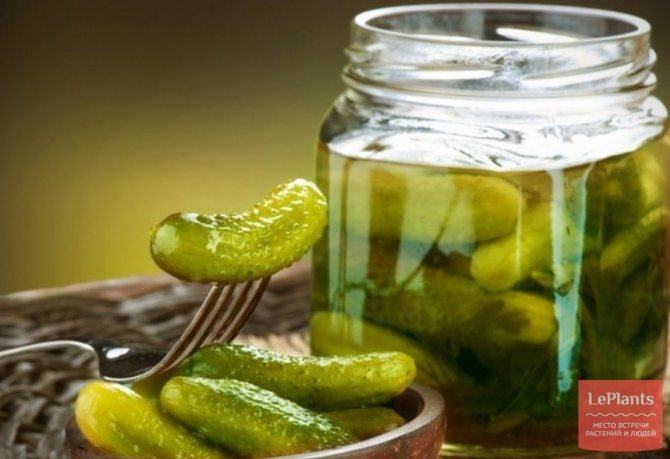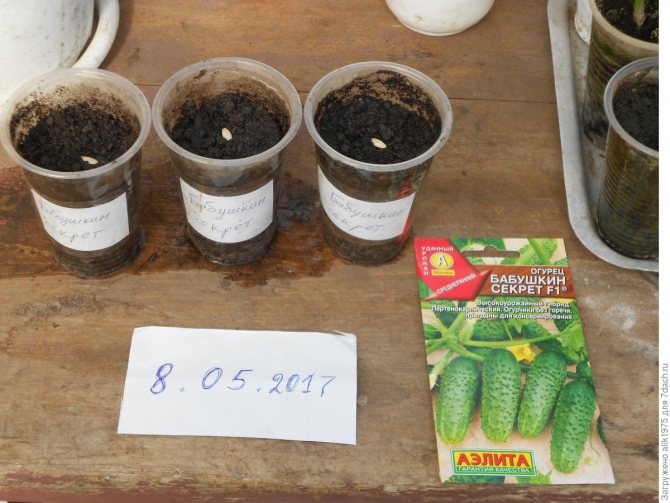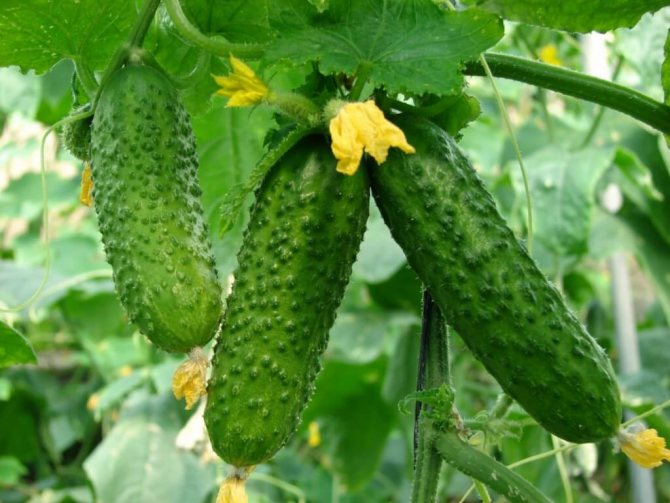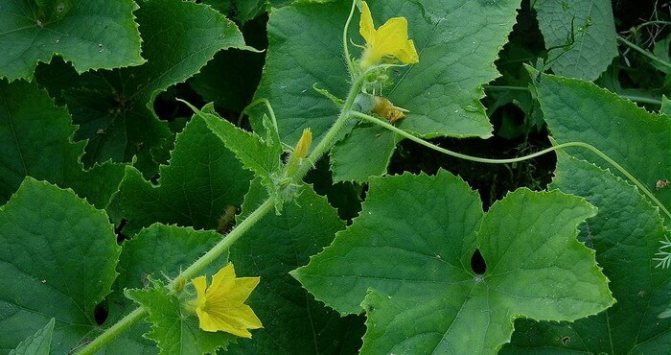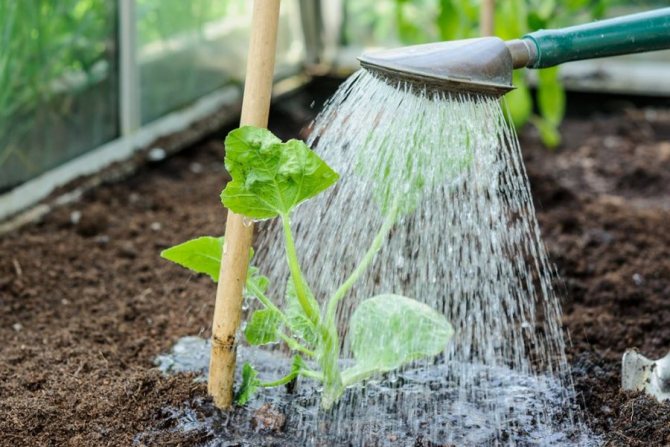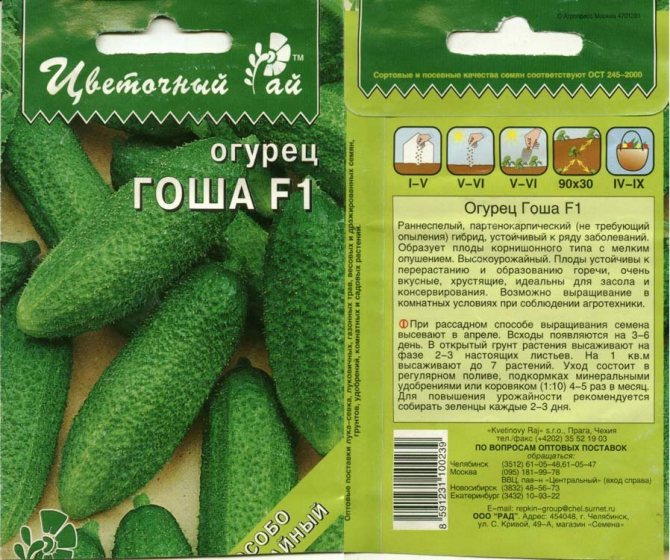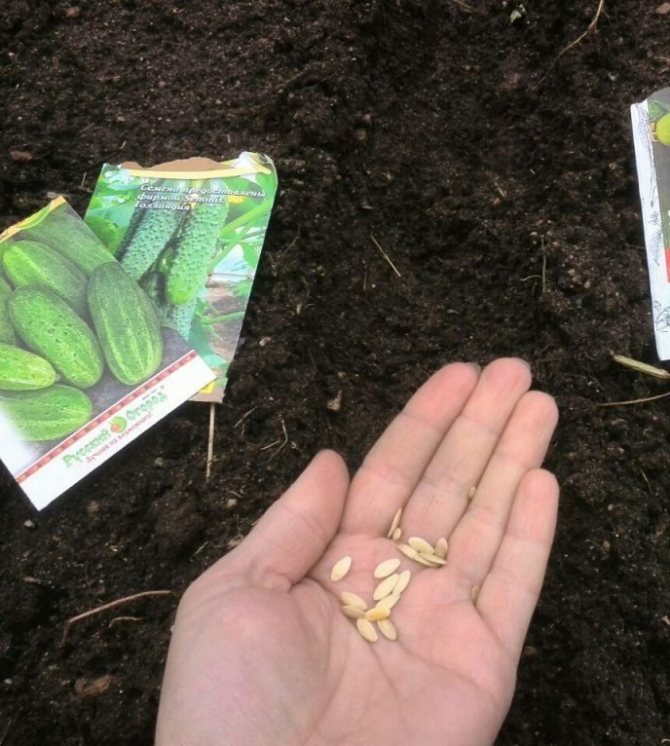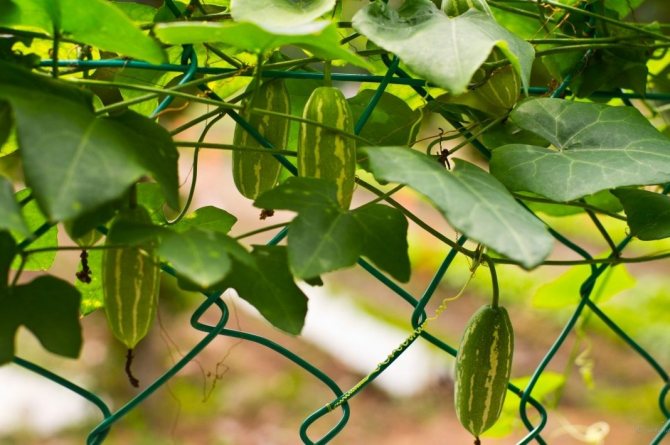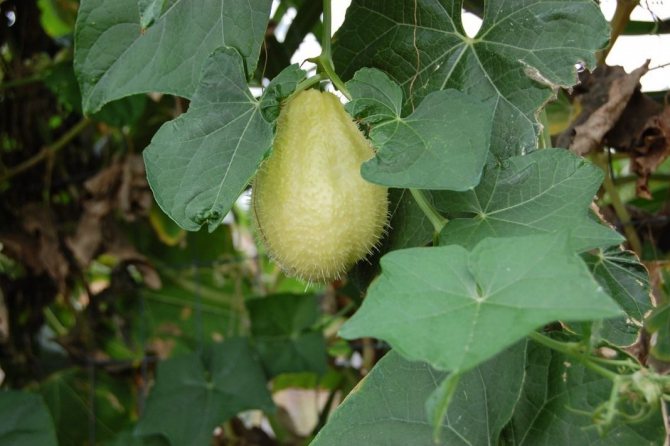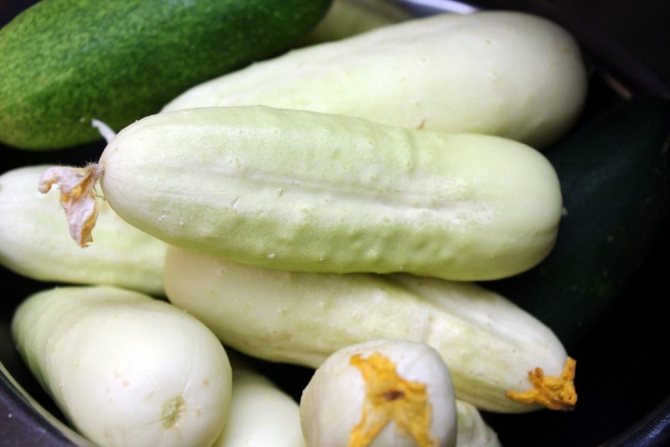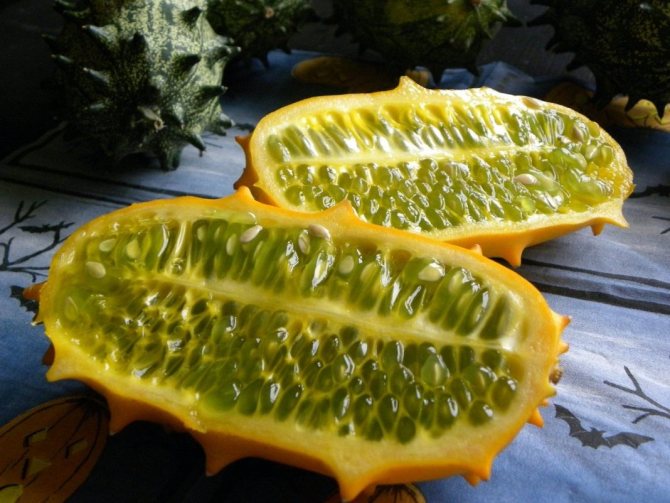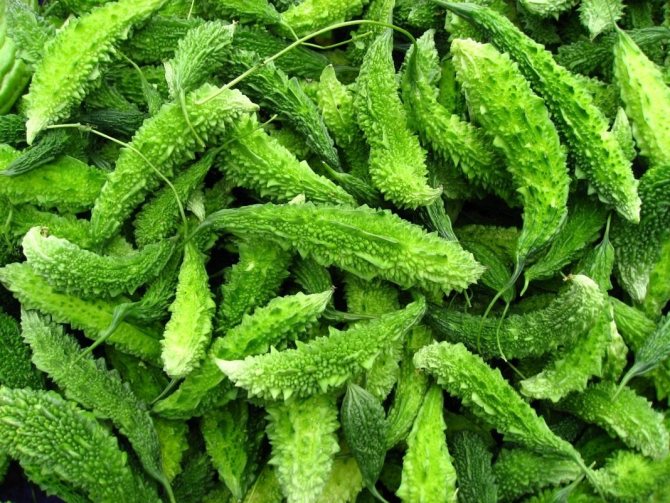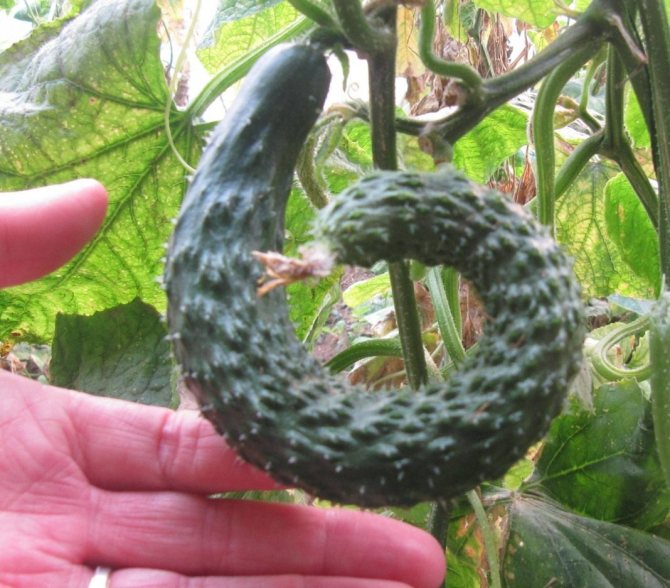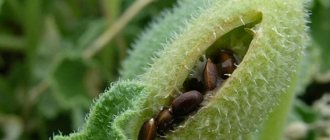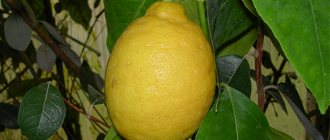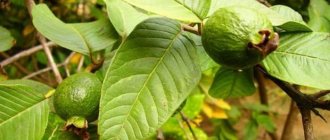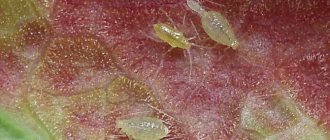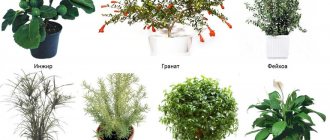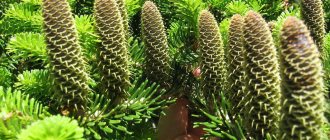Hybrids and varieties of cucumbers that form 3 or more ovaries in one node are called bundle or bouquet. The harvest when growing such cucumbers is many times greater, and the fruits themselves have a number of advantages: medium-sized, often gherkin type, crispy and not bitter. They can set fruits without pollinators. Another plus - complex disease resistance and a developed root system. Breeders are also working on the taste, the duration of fruiting.
Despite all the listed advantages, one should not think that bunch cucumbers are unpretentious and will not require anything in return. This type of fruiting - unstable genetic trait... If you take care of the cucumbers somehow, without knowing some of the features, the "bundle" will not disappear, but it will greatly decrease.
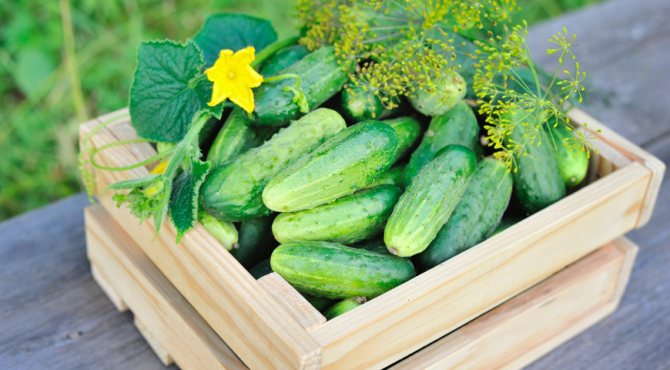
Cucumbers - botanical description
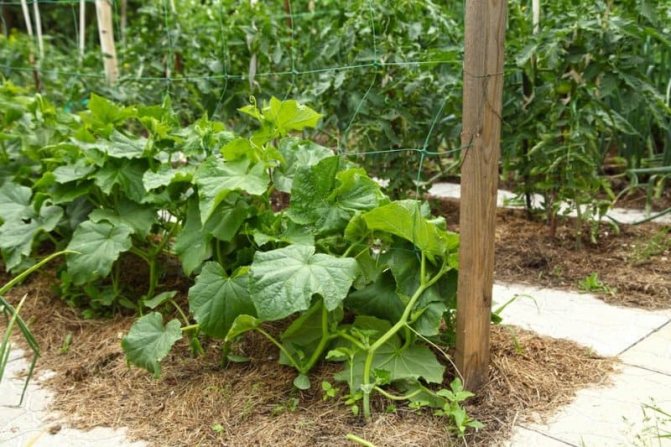

Cucumber bush
Cucumber Is an annual herb that grows both in the wild (western India) and in home gardening. Today, the culture is grown on all continents of the globe, with the exception of Antarctica.
Cucumbers develop a core root, and its main distinguishing feature is a large number of lateral processes. The entire root system is quite branched, consuming a lot of water from the soil.
Stem in cucumbers, it is often rough, less often smooth. The stems of the plant spread, tendrils are formed at the ends. Cucumbers can grow both lengthwise in a horizontal direction, and rise vertically according to the principle of a vine.
Often, the main vine can reach up to 3-5 meters in length. In this plant, a central shoot can be distinguished, from which branches of the second, third, etc. order.
To increase the yield, cucumbers need to be pinned, that is, pinch the side shoots. How to do it correctly, read our articles "All about pinching cucumbers in the open field" and "How to pinch cucumbers in a greenhouse step by step".
Leaves cucumbers are alternate, heart-shaped.
Cucumber flowers are laid in the axils of the embryonic plates. They are painted in a bright yellow hue, have jagged edges of the petals, and resemble small funnels in shape. In the buds of flowers there are glands that release nectar with a special smell into the air, which attracts insects. Today there are both monoecious (only male or only female flowers) and dioecious varieties of cucumbers. Monoecious can only be grown outdoors, as it will be difficult to create conditions for decent insect pollination in greenhouses.
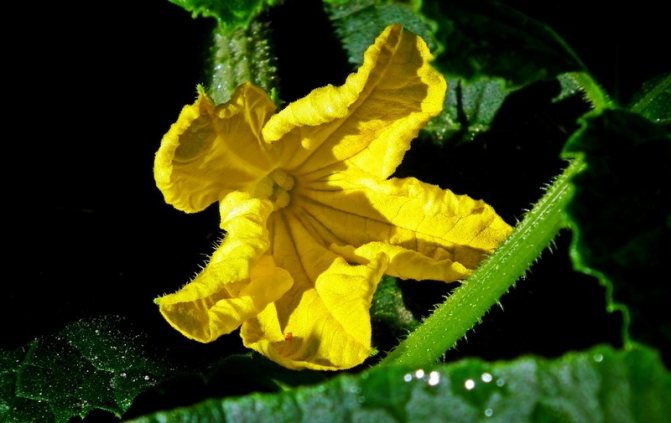

Cucumber flower
Fruit cucumbers - polyspermous, pimply, watery pumpkins (this is how they are called in botanical reference books, although cucumbers are traditionally referred to as vegetables among the people). Depending on the variety, the fruit can sometimes be completely smooth, more often with small thorns to drain moisture. Cucumbers can grow in size from 10 to 20 cm. The largest recorded fruit weighed almost 13 kg.
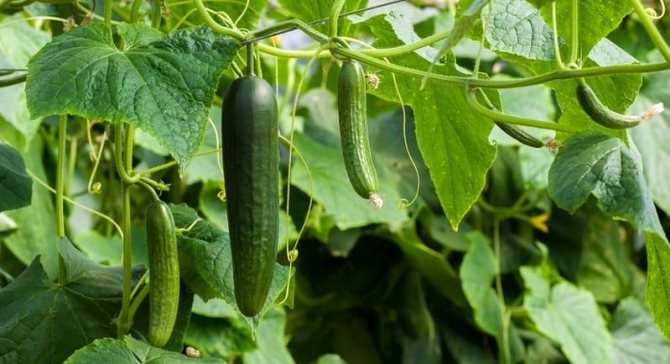

Cucumber fruit
On a bush during the life of a plant, from 2.5 to 12.5 kg of fruits can grow.
Main characteristics and description of the variety
This cucumber belongs to the parthenocarpic type,
therefore, the flowers of such a hybrid do not require pollination, and the fruits are tied on almost all flowers.The seeds of such plants, if they appear, are in their infancy. Therefore, all new seeds are obtained only by crossing certain varieties. This means that all parthenocarpic cucumbers are obtained by hybrids.
Photo of cucumber Gosh F1
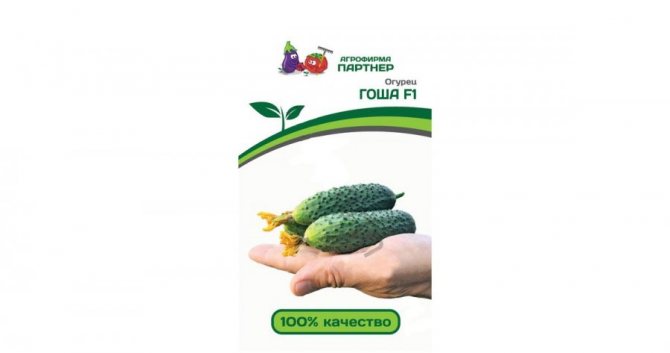

Important!
The Gosha hybrid is an early ripening variety - from the moment the seed germinates to the collection of ripe cucumbers, it takes from 40 days.
The bushes of the variety are compact, powerful, their vigor is medium. Shoots branch medium, lateral shoots develop well, their color is rich emerald. The foliage is medium in size, five-lobed, with a bright green color of the plates. The Gosh hybrid is distinguished by its shade tolerance, therefore it grows well in greenhouse conditions.
The Gosha variety is distinguished by the bouquet type of flowering - 3-4 flowers of only the female type are formed in the leaf axils, this is a self-pollinated hybrid.
Nutritional value and composition
Cucumbers are, first of all, a low-calorie product, which is 100 g. contains no more than 15 kcal. For this reason, the vegetable is key in many extreme weight loss programs (for weight loss in 3-5 days), and is also necessarily included in combined diets (for systematic weight loss in 1-2 months).
INTERESTING. Cucumbers are great helpers in weight loss due to the fact that they are 95-97% water, and also contain difficult-to-digest fiber - mainly in the peel.
In addition to fiber, cucumbers contain essential oils, organic acids, vitamins, and a rich set of minerals.
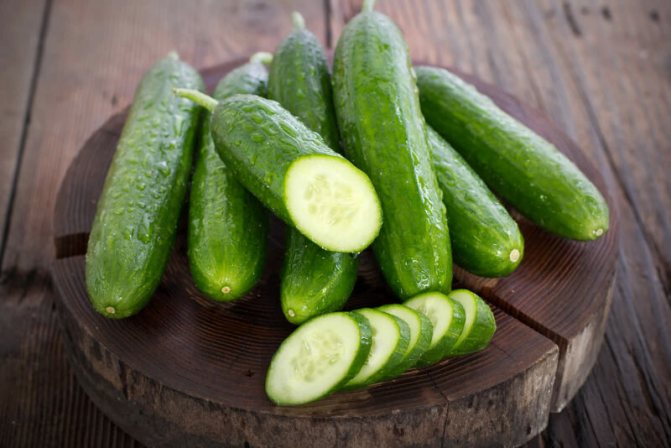

The energetic composition of cucumbers is presented:
- water = 95-97%;
- carbohydrates = 2.0-2.5%;
- proteins = 0.8%;
- fat = 0.1%.
The conditions for growing cucumbers have a significant impact on the nutritional value. So, the richness of the mineral composition of the soil, the illumination of the site or greenhouse, the frequency and quality of irrigation leaves its mark.
Vitamin and mineral composition of fruits:
- B vitamins (B1, B2, B9 (folic acid));
- vitamin C;
- iron;
- potassium;
- manganese;
- phosphorus;
- zinc;
- iodine;
- silver;
- copper.
Like all vegetables, cucumbers are rich in micro and macro elements. However, this vegetable cannot be called a leader among all horticultural crops in terms of composition. The problem lies in the high content of water in cucumbers. Useful minerals account for no more than 3-5% of the weight of this product.
Top dressing rules
When growing a Gosha hybrid in greenhouse conditions, top dressing should be applied at least 5 times during the growth period,
alternating the introduction of organic matter and mineral dressings.
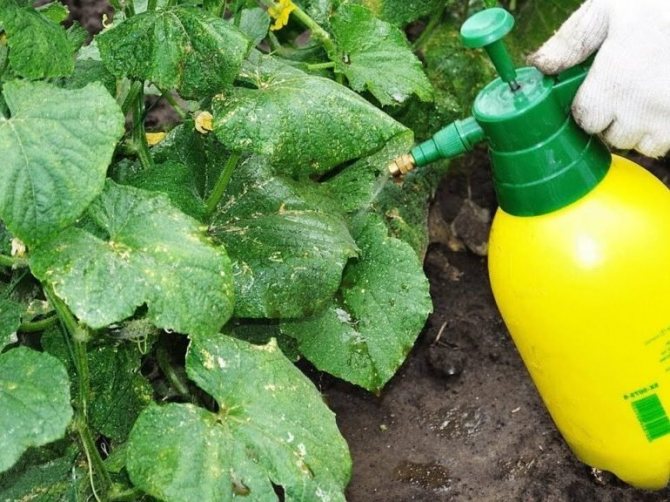

The stages of fertilization after transplanting to a permanent place of growth:
- The first feeding is applied during the flowering period. To do this, dissolve 10 g of urea, potassium sulfate and phosphate fertilizer in a bucket of water, mix thoroughly and add mushy cow dung (100 g). Instead of manure, you can use 15 g of sodium humate.
- The following feeding is carried out with the following nutrient solution: 20 g of nitrophoska and a glass of diluted bird droppings are dissolved in a bucket of water;
- Subsequent feeding is carried out with the following solution: 10 g of potassium sulfate and 500 g of cow dung are dissolved in a bucket of water. For each square of the area, 5 liters of such a liquid top dressing is required.
Classification and types
The number of varieties of cucumbers exceeds several thousand varieties. More than 1,300 varieties are officially registered in Russia alone, not to mention self-bred amateur species or numerous hybrids.
For this reason, there are a great many classifications of cucumber varieties.
First of all, cucumbers for the garden and vegetable garden can be distinguished by their ability to pollination:
- Classic - pollinated... Such cucumbers will yield only when pollinating insects have access to them.
- Self-pollinating - we can say, combined dioecious varieties (with male and female flowers), which can give up to 75% of ovaries without insect access to them. Cross-pollination with improvised means (cotton swab, etc.) may be required to increase yields.
- Parthenocarpic - varieties that do not require pollination. There are no seeds inside their fruits.
It will be relevant for Russia to evaluate cucumber varieties according to the degree of cold hardiness:
- Resistant to frost and temperature extremes.
- Unstable varieties.
Due to their resistance to weather conditions, they also share:
- Greenhouse cucumbers.
- Ground cucumbers (grown in an open way).
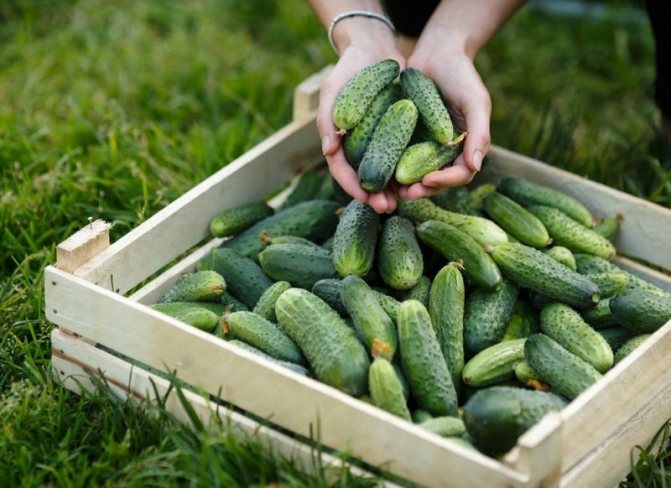

Cucumbers are usually divided by purpose:
- Salad - varieties that usually produce especially large fruits, often completely smooth. The main feature of these cucumbers is their fresh taste and pleasant smell.
- Salting - specially designed for conservation. They have a thin skin to absorb the marinade better, and are small to medium in size for easy closing in standard jars. These varieties usually do not lay well unless they are closed immediately.
- Universal - ready for fresh consumption and conservation for a long time.
- Variety - gherkins... Special varieties of cucumbers on which small fruits are formed. There are even smaller varieties - pickles. In both cases, the main feature of such hybrids is harvesting before their development to normal size.
The way the cucumbers are grown can also play a role for the farmer:
- Bush - varieties with small stems up to 1.5 m in length. Such cucumbers are easier to tie, direct in the right direction, and also pick.
- Beam - on such varieties, bunches of flowers are formed, and then fruits.
The division into varieties is quite classical:
- Early cucumbers are varieties that are mainly suitable for growing only in a greenhouse, but they can give the first harvest after a month after planting. The most common options: "Herman" (for more details see the article "Yielding Dutch cucumber variety -" Herman ")," Cupid "," Emerald "," Altai early "," Orpheus ", etc.
- Mid-season - the most popular varieties. The most important feature is the optimal fruiting time (2 months after planting), high-quality crop formation. The most popular varieties: "Athlete", "Evita", "Delikates", etc.
- Late varieties - usually the most resistant to cold and wind cucumbers, which is why they are grown more often in the open field. They are best for canning and can be stored for a long time. Popular varieties: "Harvest", "Matilda", etc.
Hybrid varieties of cucumbers can also be distinguished separately. They appear by crossing several varieties with each other. Accordingly, they absorb several positive qualities of the parents. However, these varieties are more expensive than conventional varieties and are slightly more difficult to grow.
Read about the best varieties in the specialized section.
Balcony cucumber varieties
Many people successfully grow cucumbers and get a good harvest on balconies or loggias. The prerequisites for this are a sufficient amount of light and heat. Growing cucumbers on the balcony is practically the same as traditional growing methods, except for the right choice of seeds.
For growing cucumbers on a balcony or loggia, only parthenocarpic varieties and hybrids are suitable, in everyday life they are called self-pollinated varieties of cucumbers for the balcony, in fact, the ovaries of such cucumbers appear without pollination at all.
Parthenocarp is a special case of parthenogenesis, virgin fertilization without pollination in plants, usually with the formation of fruits without seeds.
Cucumber Berendey F1
|
Cucumber City Cucumber F1
|
Cucumber Balagan F1
|
Cucumber Marisol F1
|
Cucumber Okoshko F1
|
When do cucumbers ripen?
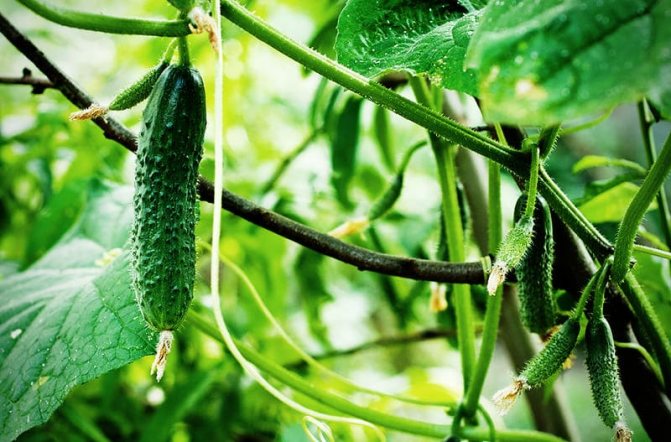

Ripe cucumber
In most situations, the ripening time of the cucumbers must be indicated on the seed packet.
In a somewhat generalized way, classical terms can be represented as follows:
| Variety | Ripening period | Growing method |
| Early | 32-40 days from the date of sowing | Hothouse |
| Mid-season | 40-55 days | Greenhouse or outdoor |
| Late | 50-60 days | Open |
Pickled cucumber varieties
Pickling cucumbers must meet special requirements, of course, this is the dimension of the fruit, biochemical composition, density. All this is necessary, as they say, so that banks are not opened.
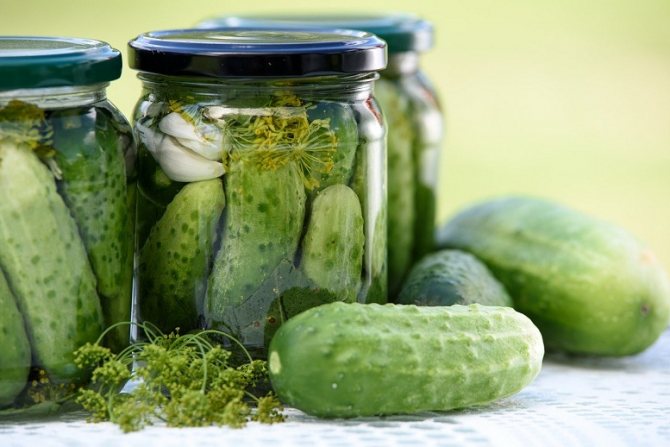

The following varieties are best suited for pickling cucumbers:
- Cucumber Berendey F1
- Cucumber City Cucumber F1
- Cucumber Balagan F1
- Cucumber No hassle F1
- Cucumber True friends
- Cucumber Fast and Furious F1
- Cucumber Ladies' Man F1
- Cucumber Kuzya F1
- Cucumber Merry family F1
- Cucumber Courage F1
- Cucumber Herman F1
How to store the fruit?
Like all vegetables, which are mostly water, cucumbers are difficult to keep fresh for long.
A vegetable can lie for no more than 5-7 days without freezing. The main thing is that direct sunlight does not fall on it throughout.
In the refrigerator, at a temperature of about + 5Co, cucumbers can be stored for about 1 week. Further, the vegetable begins to deteriorate.
The classic way to preserve cucumbers for a long time is canning. But here you need to be careful, because of the whole variety of varieties, salad varieties are slightly worse for closing in jars.
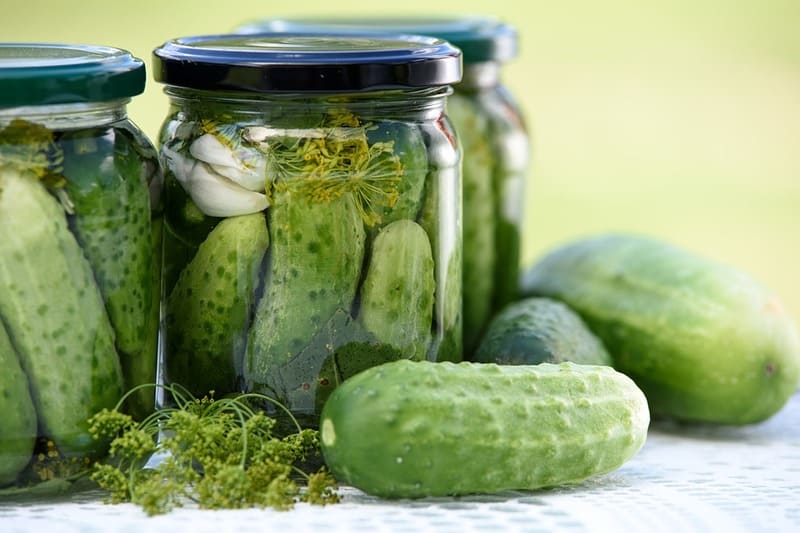

Canned cucumbers
Cucumber fruit
Fruits can vary in weight, color, pubescence, size and shape. The pubescence can be complex, mixed or simple. Hair can be black, white or brown. The color of ripe cucumber fruits can range from white to dark brown. The surface can be either smooth or bumpy. Different varieties have a different arrangement of stripes and their severity. The shape of the cucumbers is varied, but most often they give preference to the elongated - ovoid. The fruits are juicy and contain many seeds. Cucumbers with small seeds and thin skin are highly prized. They have a very pleasant and delicate taste.
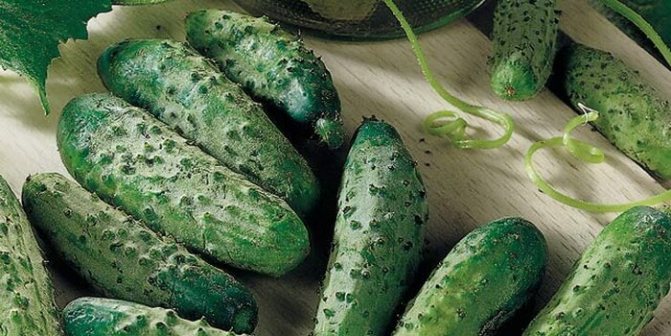

Ninety-seven percent of the fruit is water. The rest is nitrogenous, nitrogen-free and also ash substances. Carotene, thiamine, riboflavin, fiber, sulfur, iodine, many vitamins.
Beneficial features
The vitamin composition of cucumbers cannot be called particularly rich, due to the high content of water in vegetables. However, the water accumulated in them is an excellent natural absorbent that combines with harmful substances in the human body and removes them. It is known that cucumbers help the body to quickly get rid of excess fats, cholesterol and other toxins. For the same reason, cucumbers effectively help in getting rid of puffiness.
The excellent effect of cucumbers on skin condition is known. This quality is ensured thanks to thiamine (in its concentration cucumbers are ahead of beets) and riboflavin (more than in radishes).
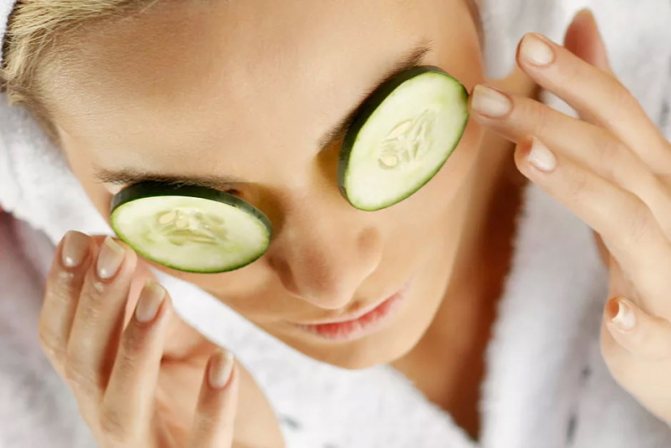

Cucumber mask
Organic acids contained in cucumbers - primarily folic acid - increase the elasticity of blood vessels.
Scientists have discovered polyphenolic substances in the pulp of cucumbers, which are excellent defenders against cancer of the uterus, breast, ovaries, and prostate.
In general, the positive effects of eating cucumbers have been seen in the following diseases:
- kidney, liver (stones);
- cardiovascular disorders (tachycardia, hypertension, atherosclerosis);
- thyroid gland (excretion of toxins, restoration of hormonal balance);
- gastrointestinal tract (constipation);
- oral cavity (bleeding gums);
Together with that, there are some contraindications, in which it is recommended to either limit cucumbers in the diet, or abandon them completely.
Due to the fact that cucumbers have a pronounced cleansing effect, they should not be used by people with diagnosed renal failure, hepatitis of all groups, gastritis, ulcers, and gallbladder problems.
It is very rare, but even cucumbers have an individual intolerance or an allergic reaction to certain substances in the composition. Obviously, in this case, this vegetable should also be completely abandoned.
Pickling varieties
Crispy and vigorous pickles are the most delicious and healthy, I think many will agree with this. It is an addition to many culinary specialties and an incomparable snack.
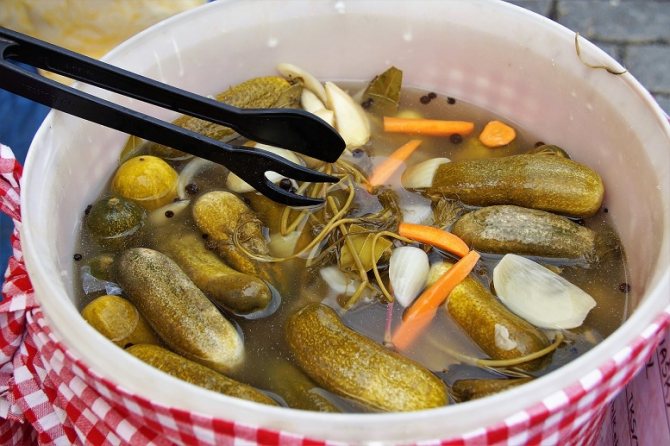

Here are the best pickled varieties:
- Cucumber Berendey F1
- Cucumber Balagan F1
- Cucumber Muromsky 36
- Pickled Cucumber
- Cucumber No hassle F1
- Cucumber Spring F1
- Cucumber Nezhinsky
- Cucumber Graceful
- Cucumber True friends
- Cucumber Ladies' Man F1
- Cucumber Courage F1
0
Cooking applications
The spread of cucumbers around the world could not go unnoticed by many national cuisines. This vegetable can be found easily in most dishes, but it is most commonly used in simple to complex fresh salads.
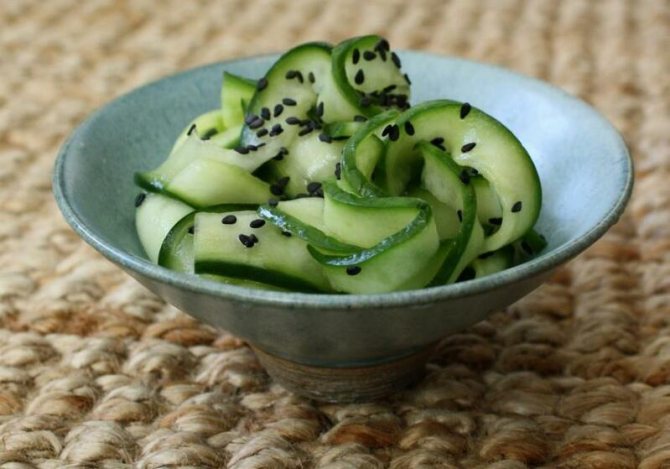

Cucumber salad
First of all, such quality as the rich content of essential oils in cucumbers is valuable for cooking. For this reason, the vegetable gives any dish a special aroma of spring freshness.
Fresh cucumber retains most of its beneficial properties. For this reason, cucumber salads are not only tasty, but also healthy for humans. Cucumbers can be served as the only ingredient in a salad, or in combination with tomatoes, cabbage, onions, garlic, bell peppers, radishes, and other vegetables.
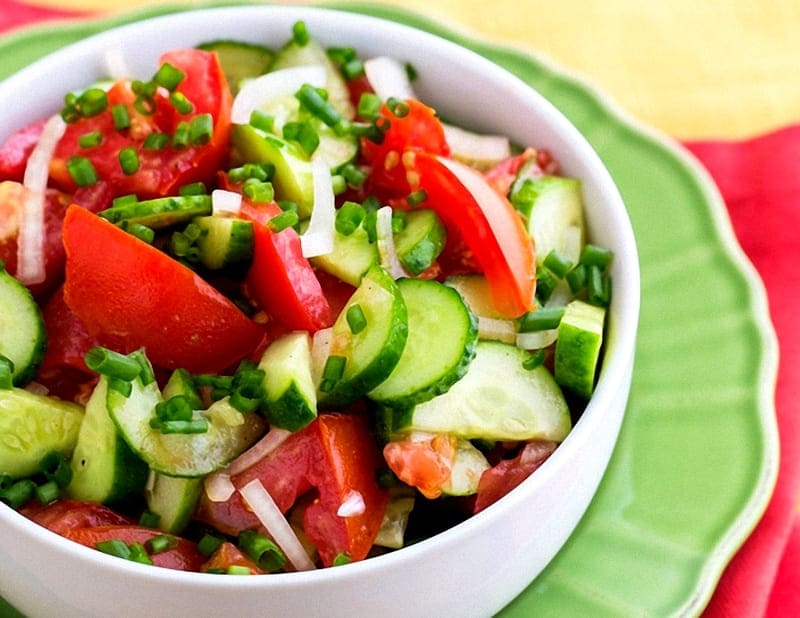

Cucumbers go well with meat, being one of the best refreshing additions to it. That is why vegetables are often served with kebabs, chops, chopped cutlets.
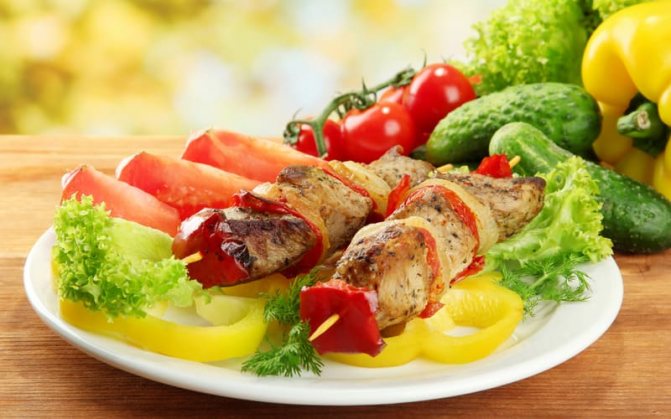

Very often, cucumbers are pickled or salted. So it turns out to keep the vegetable for a long time, until the next harvest. It is noteworthy that in this case it is permissible to preserve cucumbers both with each other and in combination with other vegetables. The most common choice is with tomatoes.
Cucumbers are also closed as an integral part of whole dishes. For example, numerous stews, prepared salads, etc. can be noted.
Forming lashes of bundled cucumbers in the traditional way
The first three or four knots are dazzling. Starting from the fifth, all emerging lateral shoots are removed, leaving in each node along the ovary (future "bundle") and leaf. In the upper nodes, 2-3 lateral shoots are left and pinched on 2-3 leaves. To prevent the shoots from shading, remove the leaf from the main stem under the trellis. Next, the stem is wrapped around the trellis and pinched. The plant is formed into one stem: in each node there is a leaf and a "bunch" of cucumbers, and only in the upper part there are lateral shoots of 2 bunches and 2-3 leaves.
Care features
Usually there is nothing difficult in growing cucumbers. But if there is a desire to grow a healthy, high-quality and tasty crop, the culture needs a little help for this.
Sowing cucumbers
Cucumbers, as a horticultural crop, can be grown by seedlings or by seed - there are no strict requirements. The main condition to which the plant is especially sensitive is warmth. Moreover, both the air (from + 16Co) and the ground (from + 14Co) should have a sufficiently high temperature.
IMPORTANT! The place for growing cucumbers should be changed every 3-5 years.
It is optimal to choose places where the wind will annoy the cucumbers least of all. Therefore, by the way, cucumbers are often planted in closed greenhouses.
In not the most favorable climate for cucumbers, namely in the temperate zone, it is better to germinate the culture first with seedlings, and then transplant to a permanent place. So it will turn out to properly harden the plant, and prepare it for rapid growth, as well as count on the harvest 2-3 weeks earlier than with the seed method of planting immediately on the open ground or in the greenhouse.
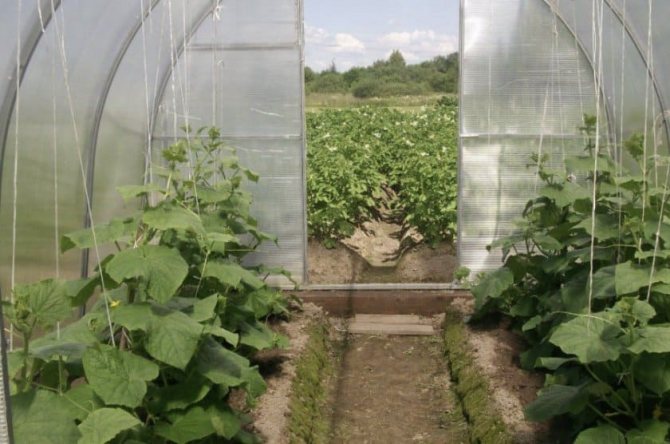

Cucumbers in the greenhouse
REFERENCE. Ideal precursors for cucumbers in the area: cruciferous (cabbage, radish), nightshade (tomatoes, peppers).
The land should be dug up before winter. In early spring, dig up the area again, remove all litter, apply mineral or organic fertilizers in 2-3 weeks.
The beds can be made at a distance of 6-10 cm between the rows. It is advisable to plant cucumbers in an elevated place, as well as to additionally protect the plants in an open area until they grow, from the wind, by erecting an earthen rampart or an artificial shield on the leeward side.
Growing in a greenhouse
Greenhouse cultivation of cucumbers is resorted to very often, because this culture is demanding on heat and humidity throughout the growth. It is much more difficult to create the best quality conditions outdoors with such requirements.
You can plant seeds or seedlings of cucumbers in the greenhouse already in mid-April. If the region is cold, then not earlier than May.
As usual, the rule applies: you need to focus on the temperature of the air and ground. The soil in the greenhouse should be warmed up to + 15-16Со, and the air must be steadily heated above + 20Со.
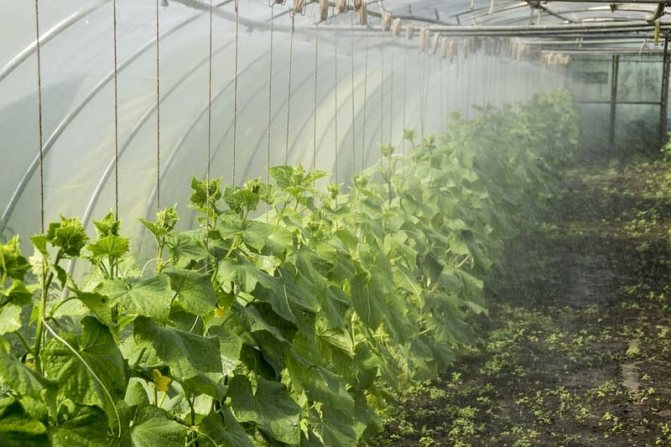

Garter cucumbers in the greenhouse
Outdoor cultivation
As a rule, for outdoor cultivation in Russia, hybrid varieties of cucumbers are needed. - especially resistant to temperature changes and wind.
It is recommended to plant only seedlings. The optimal time is the end of May or June, when frosts will almost certainly not happen.
REFERENCE. For the first time, you will need to cover the area with a film to protect it from the cold.
You may need to make the so-called "warm" beds. For this, from the last season, tops, leaves and similar plant residues or sawdust are collected. They are mixed with the soil, and only after that, beds for cucumbers are formed on the site.
Top dressing
Feeding cucumbers is one of the most important stages, which cannot be excluded from the cultivation process.
Greenhouse cucumbers are not very different from those grown outdoors in terms of fertilization tactics. So, during the season you need to try to feed the plants 4-5 times.
- The very first fertilization is a few weeks before sowing seeds or planting seedlings. Preference: mineral mixtures (optional: urea, potassium sulfate, superphosphate).
- Further feeding begins as the cucumbers bear fruit. They need to be done at least 2 times from the moment the first cucumber is picked until the last fruit is removed. Preference should be given to organic mixtures.
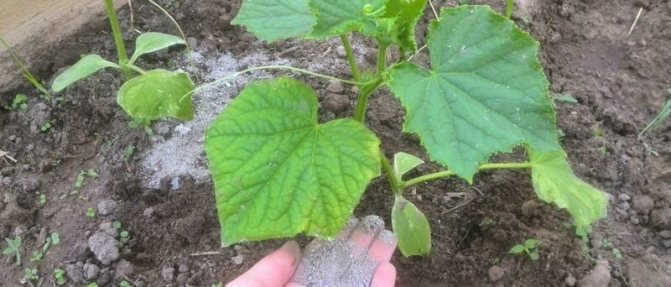

Fertilization
Watering
With any method of growing cucumbers (greenhouse or open), regular and frequent watering is the basis for a good harvest.
It is necessary to water strictly the soil under the cucumbers, but not the plants themselves, using, if possible, only warm water. For better penetration of moisture deep into the soil, it will not be superfluous to make neat punctures with a pitchfork.
The approximate frequency should be as follows:
- during flowering - once a week;
- during fruiting - 2 times a week.
IMPORTANT! In extreme heat, the frequency of watering can and should be increased. On the contrary, decrease in wet weather.
In greenhouses, you can give preference to more technically complex, but high-quality drip irrigation.
Young cucumbers need about 10 liters of water for each square meter of the plot. Adult fruiting shoots need 10 liters of water for each individual plant.
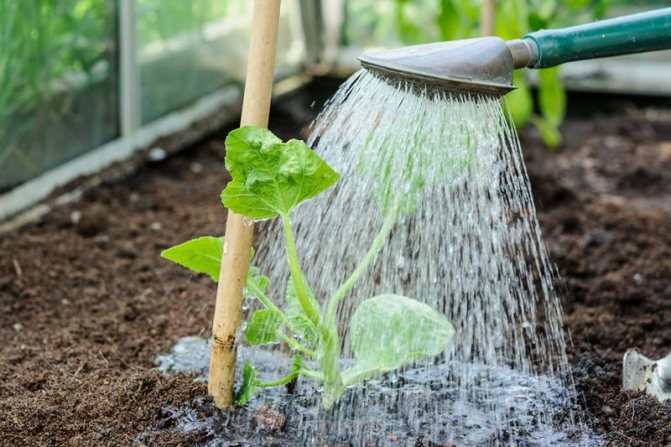

Watering
Advantages and disadvantages
The main advantages of the Gosh cucumber hybrid include
:
- high productivity;
- shade tolerance, therefore, these cucumbers grow well in greenhouses (including winter ones) all year round;
- these cucumbers can be grown practically throughout Russia in greenhouses;
- gherkin type of fruit that many consumers like and is suitable for preservation;
- good taste and marketability of ripe products;
- high immunity to diseases and pest attacks;
- harvested crop - universal purpose;
- early ripening of the crop;
- plants do not require pollination, the resulting flowers are only of the female type.
EXCELLENT VARIETIES OF CARROTS!
Flakke carrotsCarrot Autumn King
There were no drawbacks in this variety.
Open field cucumbers. Care Tips - Video
Treatment
Standard methods are used to control diseases or pests on cucumbers.
Solutions:
- Novosil (powdery mildew);
- Extraol (powdery mildew);
- Fitospirin (powdery mildew, anthracnose);
- Trichoderma (fusarium);
- Boric acid, copper sulfate, ammonia (whitefly, spider mite, aphid);
- Aktellik, Aktara (whitefly, spider mite, aphid);
- Metarizine (root gall nematode);
- Raptor, Ant (ants).
Most of the funds are quite soft, which is why you can collect the fruits and eat them within 48 hours after processing.
ATTENTION! The exact recommendations are given only by the manufacturer on the packaging!
Characteristics of Claudine F1 cucumbers
Check out these articles as well
- When to plant zucchini
- Peach variety Golden Jubilee
- Sineglazka potato variety
- The best varieties of basil with a description
Claudine F1 is considered by many experts to be one of the best hybrids. But what is the peculiarity of these cucumbers:
- From a square meter per season, you can collect 9-10 kg of cucumbers. High yield is achieved largely due to the fact that the variety is parthenocarpic.
- The harvested crop is suitable for long haul. On the way, the greenhouses do not crumple, do not deteriorate, if they are collected in time.
- The commercial qualities are high. Cucumbers are very beautiful, one to one, dense, stored for a long time, taste and aroma are pleasant.
- There is immunity to powdery mildew and cucumber mosaic virus.
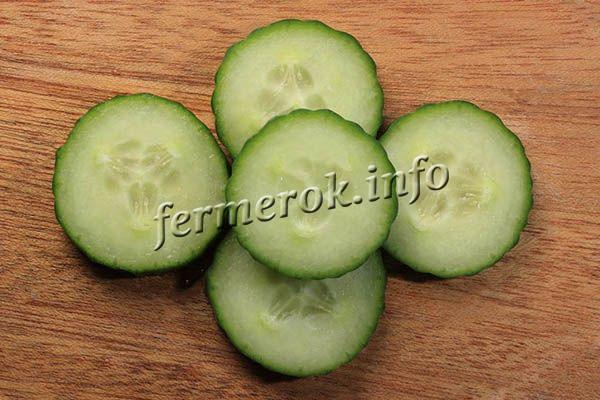

The pulp is dense, light, without voids, the taste is fresh, sweetish, without bitterness
- The bush of this hybrid is unpretentious to the place and growing conditions.
- Hybrid for salad purposes.
Important!
Cucumber Claudine F1 belongs to the first generation hybrids. This means that the seeds collected from the grown crop cannot be used for sowing next year. They do not have maternal qualities, so they may not even germinate or simply will not yield a crop!
Diseases and pests
Any garden crop is susceptible to diseases or insect pests. Cucumbers can most commonly suffer from:
- Powdery mildew - a whitish plaque caused by a fungus (by the way, it hibernates on plant debris). The leaves dry out from this disease, the fruits acquire a bitter taste.
- Anthracnose - a fungus from which sores appear on the leaves of cucumbers. The foliage dries up and the vegetables become inedible.
- Fusarium - a fungus that affects the root system, which causes a whole bush to die. The fungus is so tenacious that it may be necessary to change the entire top layer of the earth to a new one if the cucumbers get sick in a greenhouse, and not in an open area.
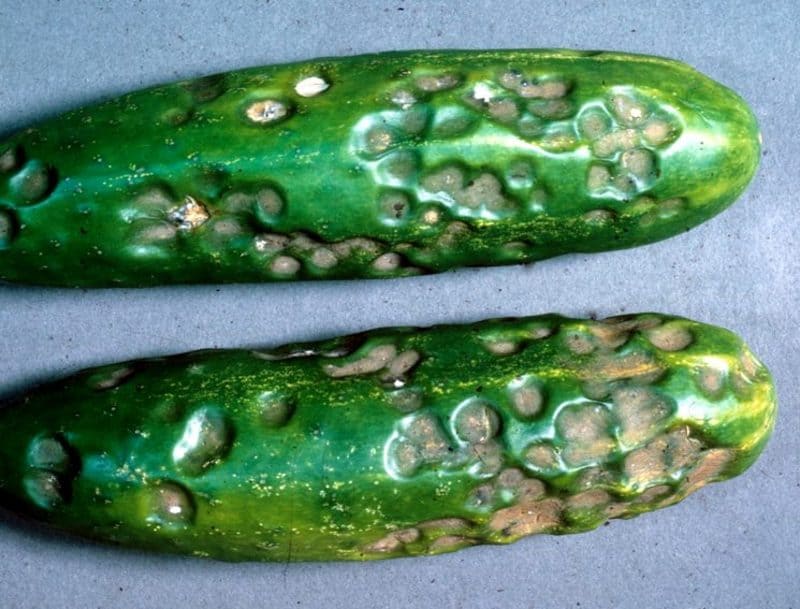

Anthracnose
Read about diseases of cucumbers and their external manifestation in our article "5 reasons why cucumber leaves turn yellow, we will tell you what to do?"
Among the pests are found:
- Whiteflies - small white insects that feed on the juice of cucumbers.
- Spider mites - pests entangling the leaves and fruits of cucumbers with cobwebs. They feed on plant sap.
- Gall nematodes - dangerous worms that infect the root system, which can lead to the death of whole cucumber bushes.
- Aphids - pests that feed on plant sap that settle on cucumbers in whole colonies.
- Ants - not only harm the cucumbers themselves, but also breed aphids on them.
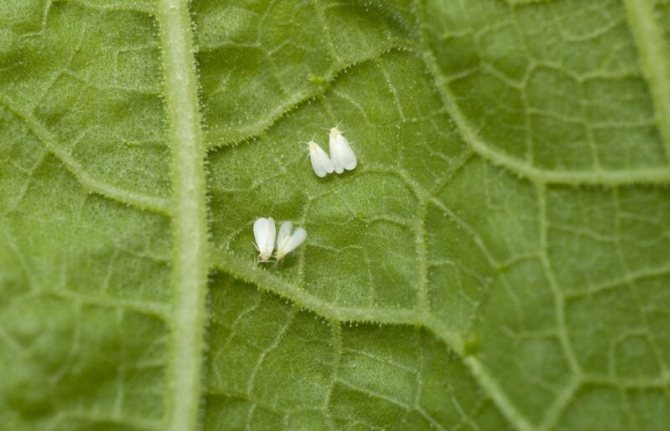

Whitefly on cucumbers
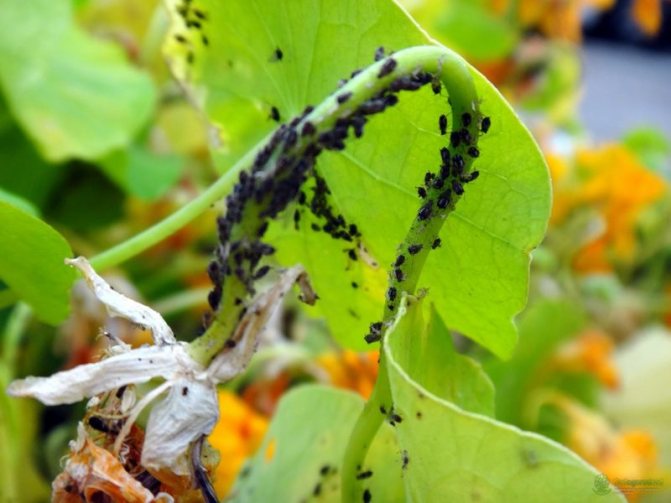

Aphids on cucumbers
Watering
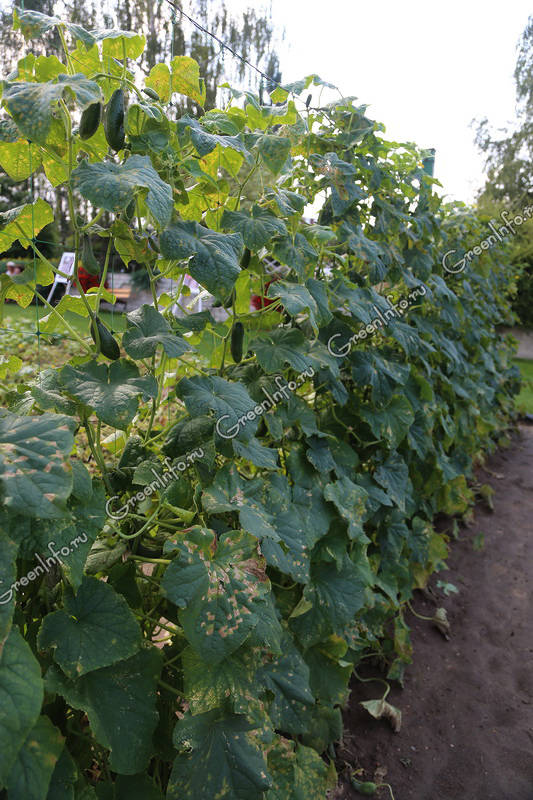

Cucumbers
Improper watering can be one of the causes of bitterness. A native of the humid warm tropics, the cucumber, although it has settled almost all over the world, is still not able to completely accept the unfavorable living conditions for it. And above all, this applies to the drought of the summer months, which is often encountered in our latitudes. From lack of moisture, the cucumber becomes bitter. In addition, a lack of water will affect not only the taste, but also the appearance of the fruit. Due to the longer ripening, the size of the greens will decrease, and its skin will darken. But the cucumber also reacts to excessive watering, especially with water from a hose, which is too cold for this thermophilic crop, and a strong pressure erodes the soil under the plants, exposing their root system and thereby contributing to the defeat of plants by root rot.
Cucumbers need to be watered so that the soil under the bushes is constantly in a moderately moist state. The amount of watering depends on the established weather and the type of soil on the site. Watering should be done only with warm water heated in the sun, in the early morning or late afternoon.The water temperature for watering cucumbers should be between 22-25 degrees. Cucumbers love to swim, so watering from a watering can with clean water of a comfortable temperature over the leaves will be perceived with great pleasure
For summer residents, a good solution would be to mulch the soil on cucumber beds with a thick layer of weeded out weeds, straw or rotted sawdust. Mulch will retain moisture in the soil longer, and will also protect the root system of plants from exposure.
Illumination
Excessive or insufficient lighting can also cause the presence of cucurbitacin in zelens. Cucumbers are photophilous, they like bright, but diffused light, direct sunlight burns them in hot weather, plants react to stress with increased production of cucurbitacin. Since the bush can be illuminated by the sun in different ways, on the same bush there may be fruits of different taste: those that were in the shade of the foliage will have a normal taste, and those that overheated in the sun will be bitter. Those cucumbers that have grown in insufficient lighting due to the wrong choice of their planting site, thickening of plants or strong shading by taller neighbors will also taste bitter.
It is necessary to plant seeds or seedlings of cucumbers in the garden at intervals of 20-30 cm in a row and 40-50 cm in aisles. Long-leaved varieties require timely pinching, shoots should not grow more than 1.5-2 m. In the open field, for natural shading of cucumbers on the southern side of the garden, you can plant corn or sunflowers. Cucumbers grown on a trellis can be protected from the hot sun by throwing a lightweight non-woven material over the upper crossbar of the structure.
When growing cucumbers in a polycarbonate greenhouse, the material itself gives it a bright, but diffused light. In the southern regions, the ceiling and walls of a glass greenhouse can be whitewashed or shaded from the outside with special shading nets for greenhouses to reduce sunburn.
Interesting Facts
- It is safe to say that cucumbers descended from the same ancestor as melons.
- A well-known feature of cucumbers is that they are eaten unripe. Therefore, in Greek "aguros" means "unripe", "unripe", and in Russia the name cucumber is derived from the Greek version.
- Thorns on cucumbers are by no means a defense mechanism, but a way to remove excess moisture. In the early morning, for example, droplets of liquid can be seen at the ends of the thorns.
- Cucumber is the vegetable with the highest water content. Fruits usually contain 95-97% water.
- Finding wild cucumbers today is quite problematic. This plant, without human attention, grows only where it spread throughout the world: in the territories of modern India and Pakistan, at the foot of the Himalayas.
- In the Middle Ages, cucumbers were certainly part of the provisions for long sea voyages. Thanks to cucumbers, scurvy could be avoided. And a big plus of this vegetable is that it did not spoil for a long time if it is salted.
- Cucumber mask is one of the most common and simple face skin care options.
- Cucumber gruel relieves pain from sunburns as well as sour cream.
- The world's first cucumber greenhouses (hotbeds) were built in ancient Rome. Cucumbers were grown there for fresh consumption and pickling for the winter.
- One of the oldest references to cucumber can be found in the Bible. So it is called "the vegetable of Egypt." By the way, in Ancient Egypt, cucumbers were placed in the tombs of pharaohs and wealthy nobles on a par with golden gifts for the afterlife.
- Information has reached our days that people have been consuming cucumbers for at least 4500 years, since the time of the Mesopotamian civilization. And as a domesticated crop, the vegetable was grown already in ancient India.
- For a long time, cucumbers have been used both for medicinal purposes (in Ancient Greece) and as oral care. It is known that the cucumber wedge pressed to the palate effectively fights bacteria - the source of bad breath.This was noticed by our ancestors, and they used it before the advent of toothpastes.
- A kilogram of cucumbers contains only about 140-150 Kcal.
- Few vegetables can boast of their own holiday. But a cucumber has such a day on the calendar - July 27.
- One of the reasons for the bitterness in the fruit of cucumbers is the lack of moisture during cultivation.
What makes cucumbers bitter?
Cucurbitacin gives bitterness to cucumbers. Cucurbitacins belong to the class of tetracyclic triterpenoids and represent a whole group of structurally similar substances, each of which received, in addition to the main name, an additional Latin letter from A to R. In plants, cucurbitacins are contained in the form of glycosides, which, under the action of the elastase enzyme, break down into free cucurbitacin and sugar.
All cultivated cucumbers contain cucurbitacin B and cucurbitacin C, toxic organic compounds that should make their leaves bitter and less palatable to leaf-eating insects and animals. In addition, cucurbitacin increases the germination and germination rate of seeds, as well as the resistance of the crop to stress. These compounds are usually concentrated in the leaves, stems and roots, that is, those parts of the plant that people do not eat, so we do not know that they are there. Only when they turn into the greens themselves, we begin to feel a bitter taste, although a sweet cucumber also contains this substance, but in a minimal amount. Because of this feature, in the 18th century, cucumbers were even considered poisonous and were not eaten. Usually, not all of the cucumber turns bitter. More often than not, the bitterness will concentrate on the tips and the area just under the skin.
Note that today cucumber, on the contrary, is considered a medicinal plant and precisely because of the cucurbitacin content. Cucumber helps to improve the functioning of the liver and intestines, and reduces the risk of malignant tumors. Scientific research conducted in different countries of the world since the second half of the twentieth century has proved that cucurbitacins have a wide range of very important biological properties, such as antitumor, contraceptive, anti-inflammatory, antimicrobial, anthelmintic, etc. However, official medicine is not yet ready to call us as prevention or, moreover, treatment of serious diseases, eat bitter cucumbers.
Few people know that not only cucumbers, but also many other plants are protected from being eaten by animals using similar mechanisms. For example, plants of such delicious melons as pumpkin, melon or watermelon contain saponin, an organic compound with a bitter taste, akin to cucurbitacin. The very name of the pumpkin family arose from the Latin name for pumpkin - Cucurbita pepo. Moreover, these substances are contained not only in food, but also in non-food representatives of this family, for example, white step, he is also white bryony (Bryonia alba), mad cucumber, or lobed echinocystis (Ecballium elaterium), etc., as well as representatives of others families, for example, eleocarpus (Elaeocarpus hainanensis), etc.
Most of all, unripe fruits and overripe specimens growing in unfavorable conditions, as well as those vegetables that grew from the seeds of bitter cucumbers, are prone to bitterness. Therefore, when planting, choose varieties and hybrids that are resistant to bitterness and be very careful when selecting specimens for self-collecting seeds.
To the question - what is wrong with the plant, as always, there is no single answer. But this is what makes truck farming and gardening so interesting!
There is no consensus on what causes strong bitterness in the fruits of cucumbers, but all experts agree that the culprit for this phenomenon, which is offensive to us, is this or that type of stress that the plant experiences during growth. Unfortunately, we cannot tell if our cucumber turns bitter while it is still growing.But while we cannot fix the problem before it happens, we can try to avoid further growing conditions that are potential culprits for the bitter taste of cucumbers, and try to get a rich harvest of cucumbers with excellent taste.
Output
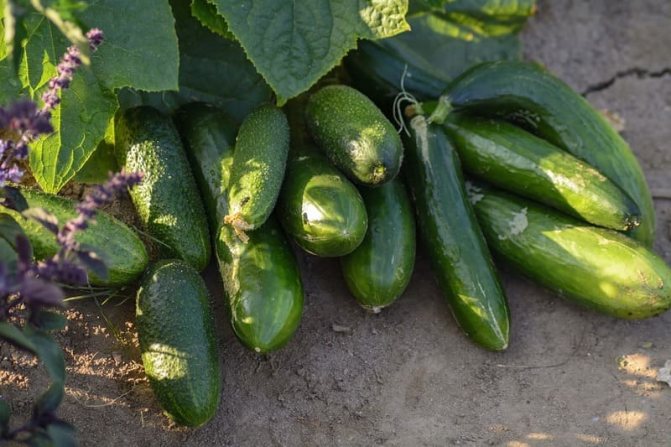

Cucumbers can rightfully be called one of the most common horticultural crops in the world. And the point is not only in the huge species diversity, but also in the combination of a special, recognizable taste, qualities useful for the human body, and ease of cultivation.
This time we talked about the history of the cucumber, reviewed the classification of all known species, got acquainted with the care of cucumbers and the basic rules of cultivation. We really hope that such a comprehensive knowledge of this horticultural culture will benefit everyone and will allow you to grow an ideal harvest of cucumbers annually on your site without big problems.
Formation of hybrids of cucumbers with good branching
In the lower part of the stem, 3-4 knots are blinded. In the next 3 nodes, the ovaries are left, but the lateral shoots are removed. Further, in 3 nodes, ovaries and lateral shoots are left, which are pinched onto one leaf with an ovary. In the next nodes to the trellis, the shoots are pinched already on 2 leaves with ovaries. Under the trellis itself, that is, in the two upper nodes, lateral shoots are sometimes pinched onto 3 leaves with ovaries, if they do not shade the lower ones. The main stem, as in the first version, is twisted around the trellis 1-2 times, fixed and pinched.
How to salt cucumbers
Currently, this method of processing vegetables is the most popular. There are many variations of pickling cucumbers, which differ in the quantitative composition of salt, herbs and spices. You can prepare vegetables for future use in two ways: "cold" (without sterilization) and hot.
Spices for pickling cucumbers (for a three-liter jar):
- black pepper - 10 pcs;
- garlic - 50 g;
- horseradish root - 6 cm;
- currant leaf - 3 pcs;
- cherry (or oak) leaf - 3 pcs;
- bay leaf (dry) - 2 pcs;
- dill inflorescence - 2 pcs;
- grape leaf - 1 pc.
If desired, add a sprig of tarragon, mint, basil or savory to the bottle.
Hot method of pickling cucumbers
- Place spices (including fresh plant leaves) on the bottom of the jar.
- Lay cucumbers on top of the spices (preferably vertically).
- Pour boiling water over the raw materials, cover with sterilized lids, and stand for 3 minutes.
- Drain the water into a prepared container. For ease of use, you can use a lid with holes or an ironed gauze cut.
- Pour boiling liquid over the cucumbers a second time, increase the infusion period to 5 minutes.
- Drain the hot water into a saucepan. Prepare the marinade (taking into account 35 g of salt per 1 liter of the original liquid).
- Pour the pickles with boiling brine (without filling the neck), roll up the jars.
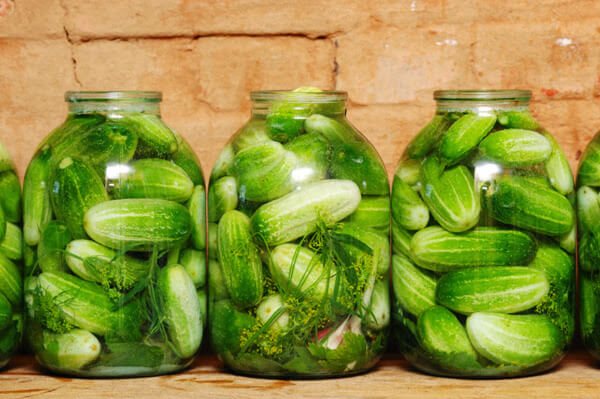

After preservation, the pickles are turned down with lids (until they cool completely), wrapped up and put away in a cool place a day later.
Cold Pickled Cucumber Recipe
- Place the cucumbers, spices and fresh leaves in the prepared container.
- Prepare the marinade. To do this, the salt is dissolved in 100 ml of hot water (based on 55 g of spice per 1 liter of liquid). The resulting mixture is brought to the required volume with ice water.
- Pour cold brine over the cucumbers, leave warm for 1-2 days (to activate enzymatic processes). After the end of fermentation, top up the brine to the top of the jar and seal it tightly with a lid (without sterilization).
- Move the pickles to the refrigerator or cellar for 10-12 days.
The optimum storage temperature for the product is 0 degrees.
Secrets of proper salting
- For crispy cucumbers, it is better to choose small fruits with black “pimples” and thick skin.
- Vegetables should be soaked in water for 2.5 hours before pickling. Otherwise, they can taste bitter or "explode".
- The optimal time for pickling cucumbers is the second half of July-August.
- For the preparation of the marinade, it is better to use filtered, well or spring water.
- Greens, to preserve taste and aroma, should be plucked from the bush one hour before salting.
- Cucumbers are placed in a bowl in dense rows in an upright position.
Remember, the more vegetables you can fit in the jar, the longer the product will be stored (due to the increased concentration of lactic acid during fermentation).
- Vegetables that are in the fermentation stage (when using the "cold" method) should never be covered with a lid.
- For crispy fruits, it is important to use coarse table salt without additives.
- To avoid the appearance of mold during the "cold" salting of cucumbers, it is necessary to sprinkle the surface of the marinade with dry mustard powder.
- To preserve the bright green color, the vegetable is poured over with boiling water, and then immersed in cold water.
To get crispy cucumbers, it is important to place them exclusively in a sterile container. Remember, in 80% of cases, salting spoils due to careless preparation of dishes.
Agrotechnical features
Anguria is a thermophilic plant. When the temperature drops to +10 ° C, it stops growing. With an increase in temperatures, growth resumes, with a decrease below 5-6 ° C, the liana dies.
The place where the Antilles cucumber will grow should be well warmed up by the sun and protected from the wind. The plant does not like shade and thickened plantings. Ideally, the bed should be located on an elevation where rainwater does not stagnate.
The soil must be fertile and well-drained. Black soil or sandy loam soil with neutral acidity is suitable.
Acidic soils and the proximity of groundwater can destroy the plant.
If the required soil is not available in your area, it can be adjusted by adding a sand-peat soil mixture to the site. To reduce acidity, lime must be added.
In the selected area in front of Anguria, legumes, roots, greens, early cabbage can grow.
A horned cucumber will grow poorly in a garden bed where any pumpkin crops were its predecessors.
Techniques for increasing the yield of cucumbers
Based on the peculiarities of the culture, experienced vegetable growers have long found out that high-quality care and pinching of lashes are far from all the tricks in terms of increasing the yield of cucumbers. There are other ways to enhance the formation of female flowers. One of them is to temporarily stop watering just before the flowering of the crop. This technique makes the plants "think" that they may soon die and provokes intense fruit formation.
Another option for increasing yields is mixing different varieties and hybrids of crops in plantings - this enhances the cross-pollination of cucumbers.
You can also make ringing of the stems - make a shallow circular incision under the first pair of leaves of the plant (the procedure is performed only in dry weather), which will complicate the outflow of nutrients to the roots and contribute to the formation of more ovaries.
At the time of the decline in the formation of zelents, you can make foliar feeding of cucumbers with urea (at the rate of 20 g per 10 liters of water), but only either on a wet evening or in cloudy weather.
Increases productivity and removal of the first ovary. This technique allows the plant to strengthen the root system and gain strength for the formation of a large number of fruits. You can also try attracting bees to your area - either by planting melliferous plants, or by arranging drinking bowls with aromatic syrup.
A separate word must be said about supports. Since the cucumber is a climbing plant, the best option for growing it is vertical. Supports can be of different options: inclined, vertical, arranged along the garden bed or round - here as it is convenient for anyone.The main thing is that the plants on them will not touch the ground, they will be better ventilated, it will be easier to harvest from them, which means they will hurt less and bear fruit more abundantly.
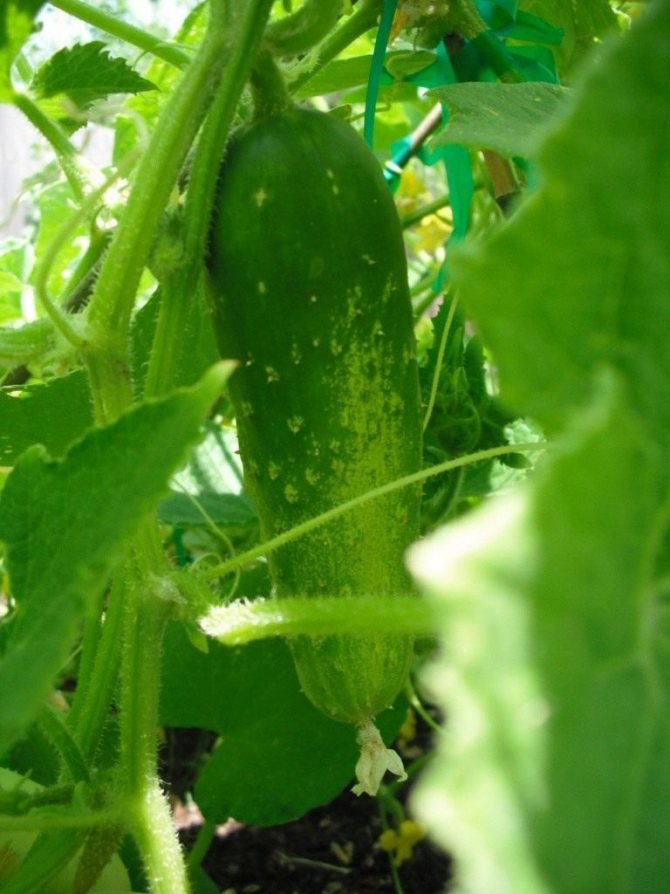

Cucumber. <>
Cucumber Care Claudine F1
The Claudine F1 cucumber needs easy maintenance. He has no special requirements. But this does not mean that you can plant cucumbers and just harvest as soon as they appear. The basic rules of care must be observed.
- At the initial stage of growing, it is recommended to remove all weak sprouts. In their place, you can plant healthy seedlings or sow new seeds.
- Watering is carried out as needed. It is very important that the earth has time to dry out, but not dry out. Cucumbers are watered abundantly so that the earth is well nourished. Do not forget that lack of water can negatively affect the taste.
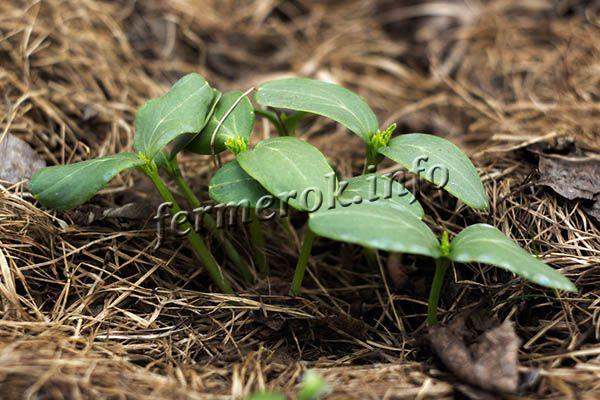

Under the bushes, you need to regularly remove weeds or mulch the soil.
- Under the bushes, you need to regularly remove weeds or mulch the soil. This is done so that diseases do not breed on the site, in addition, weeds take nutrients from the bushes.
- It is necessary to form bushes. All flowers and shoots are removed from the first sinuses. In the bosom of 5 leaves, 1 ovary must be left. In the bosom, 7-10 leaves are already left by 2 ovaries. When the bush reaches a meter in height, you can pinch the top to prolong the fruiting of the bush.
Interesting!
From mid-August, you can start hilling bushes. This will cause lateral root development from the stem and prolong the yielding period.
- The hybrid responds well to the introduction of organic matter and minerals (nitrogen, potassium, phosphorus) into the soil. With growth retardation, nitrogen is introduced, and during flowering, the appearance of ovaries - potassium and phosphorus. But the infusion of wood ash, which is made from 10 liters of water and 300 g of wood ash, can be sprayed on the bushes throughout the season.
Adequate care allows the cucumbers to develop properly. This increases the yield of the bushes.
Books about cultivated plants. Cultivated plants
All about pests, weeds and plant diseases
Maxim Zhmakin Garden and Vegetable Garden Four seasons (Ripol) 2011
In this book, you will find basic information about pests of cultivated plants (insects and animals), as well as learn about how to deal with them. You will learn about the most common weeds and their control methods. In addition, you will receive a lot of useful information about diseases of cultivated plants and methods of their treatment.
The plants that tamed us
Gennady Avlasenko Other educational literature None N / A
The popular science book by Gennady Avlasenko "Plants that Tamed Us" tells in an accessible and fascinating way about the origin of certain cultivated plants, about the history of their gradual domestication by humans, as well as about the purpose for which people domesticated and began to widely cultivate certain plants.
The publication also contains many interesting facts about these plants.
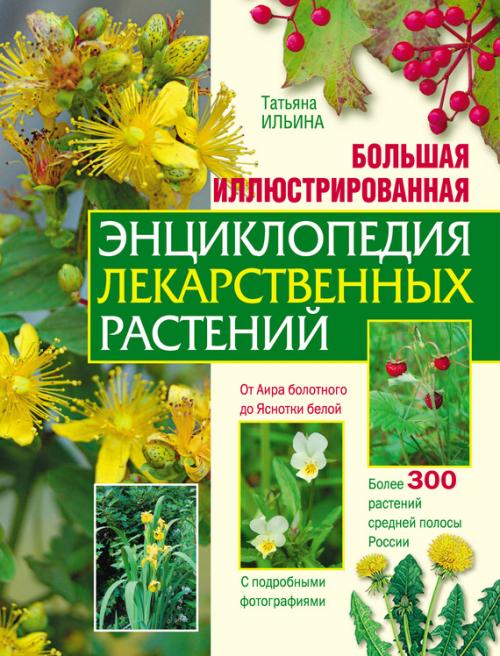

Great Illustrated Encyclopedia of Medicinal Plants
T. A. Ilyina Medicine Beauty and health (Eksmo) 2015
Healing plants are an invaluable treasure of nature. For centuries, our ancestors used herbs to heal diseases. However, over time, the knowledge passed down from generation to generation has ceased to be available, and now many people who understand the benefits of medicinal plants and who want to use it, not only do not know how to do it correctly, but also have no idea what it looks like. this or that medicinal plant.
This book is unique. It is also a guide to plants, both wild and cultivated, which can be used for medicinal purposes, as it contains visual photographs of them and full characteristics. And the herbalist - thanks to a variety of recipes used for the most common diseases, with precise dosages and a detailed description of the preparation process.
And a guide to the collection and preparation of medicinal herbs. And even a guide for the cultivation and care of cultivated medicinal plants. The author of this encyclopedia, T. A. Ilyina, Candidate of Biological Sciences, summarized her own experience and professional knowledge.
We hope this book will bring health to your home!
What to cover
To protect cucumbers from late return frosts, temporary shelters are made over the beds. They allow you to plant plants and get the harvest earlier. Arcs are best suited for these purposes - metal or from willow rods, which are installed over the garden. A shelter is thrown on top of the arcs. The most suitable for these purposes is agrospan or other similar white material. The film for covering the beds is used only in case of severe cold and frost, on cold nights, when the temperature drops below + 8 ° C. It is thrown over a nonwoven fabric.
The arcs are then used as whip supports instead of trellises.
Photo gallery: flint shelters in cucumber beds
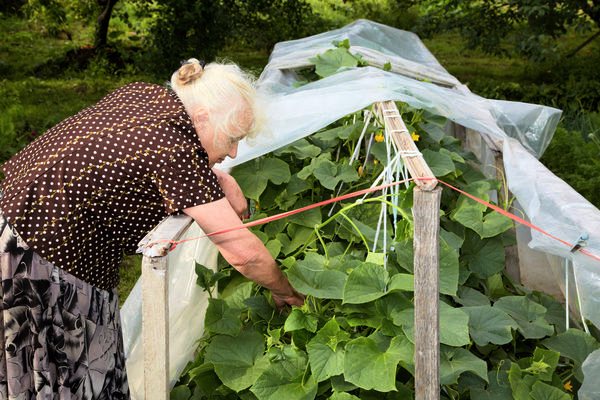

Sheltered from the wind and cold, cucumbers do not get sick and give a good harvest
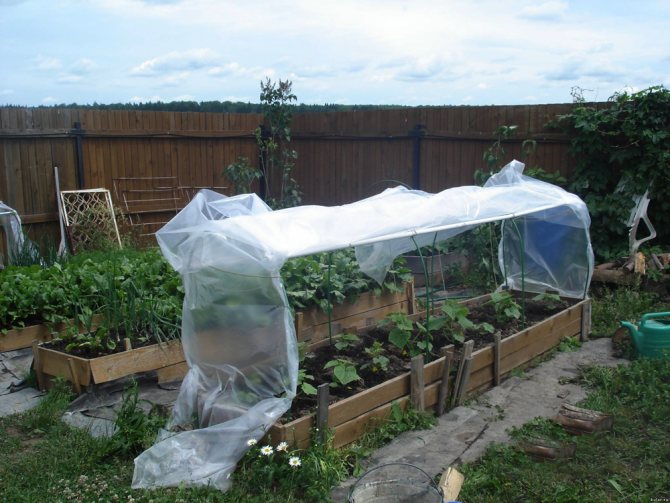

In a particularly cool summer, cucumbers feel good under the film.
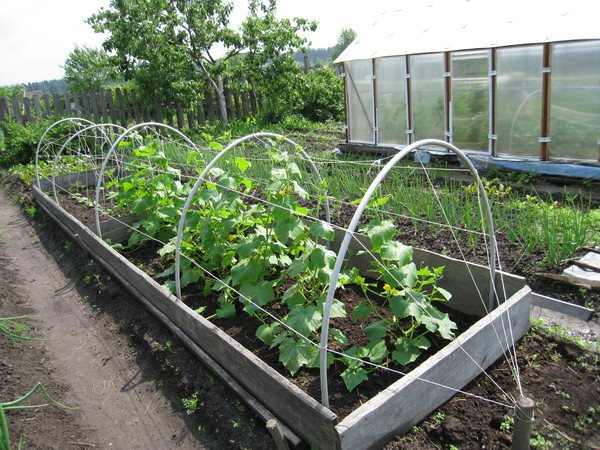

Arcs to support a temporary shelter made of agrospan also serve as a trellis for tying whips


The original greenhouse for cucumbers, after the threat of frost, turns into a trellis
Reviews of gardeners about the Claudine F1 cucumber variety
Gardeners love the Claudine F1 cucumber for its delicious taste and ease of growing.
- Sofia Mirshavka: “I love cucumbers Claudine F1. They grow quickly, even if the seeds are sown directly in the garden, they hardly get sick, and give large yields. At one time I tried to grow them in a greenhouse, but the yield there was not higher, so now I plant only in open ground. The crop is not good for canning, but it is a great variety for food. Cucumbers have a pleasant, refreshing taste, what you need for summer salads! "
- Tatiana Sklyar: “Cucumbers are usually grown by seedling method, so they develop faster. I also grow Claudine F1 through seedlings. The sprouts are strong, with a thick stem, do not break. Only 1-2 seedlings can be weak out of a dozen. After diving into open ground, they quickly take root. I harvest as soon as the cucumbers grow up to 10 cm. While young, these cucumbers are very tasty! "
- Igor Veremey: “For several years now I have been planting Claudine F1 cucumber on the site. Last year, the bushes got sick with powdery mildew - treated with fungicides. Plants quickly recovered and gave a good harvest, but still less than on healthy bushes. Zelentsy are beautiful, tasty in this hybrid, I like the fact that they have a thin skin and pleasant, juicy pulp, I have never noticed bitterness ”.
Cucumber
India and China are recognized as the homeland of this wonderful vegetable, but Russian gardeners have long brought it far to the north and created varieties that are phenomenal in early maturity and cold resistance. In the southern vegetable gardens, the cucumber is second only to tomato in area, and in the northern beds it loses only to cabbage. Local Russian varieties have long been bred in almost every province throughout the vast country (with the exception of the Far North). The nationwide love for a modest and "frivolous" product seems surprising. Moreover, cucumbers contain about 96% of water (however, according to the catch phrase of the founder of the Department of Vegetable Growing of the Moscow Agricultural Academy V. I. Edelstein, "this water is not tap water ..."). But the craving for fresh cucumbers is not at all accidental - their juice is rich in physiologically active substances. In addition to mineral salts, including essential trace elements, it contains vitamins and enzymes that promote their assimilation.
For thousands of years, cucumber has been used both in medicine and in cosmetology. Fresh fruits are known for their pronounced diuretic effect, as well as a laxative and antipyretic agent.The alkaline reaction of the pulp makes it an indispensable product for people suffering from high acidity of gastric juice. In addition, the fiber in the fruit is not coarse, it does not injure the gastrointestinal tract, but only helps to cleanse it.
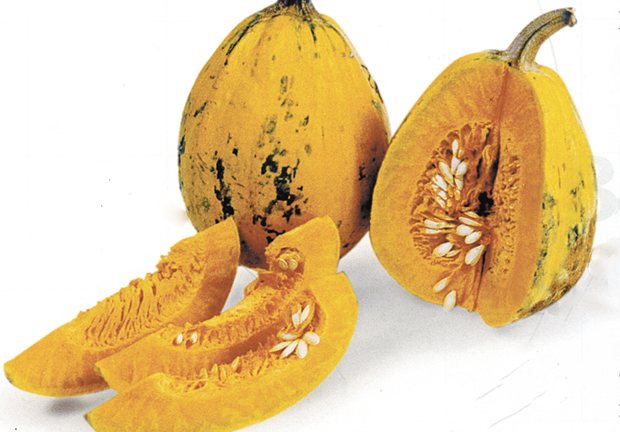

After what crops can cucumbers be planted
Cucumbers should not be grown in one place for two years in a row; it is advisable to plan the return of the crop to the garden in the third or fourth year. This is due to the fact that they very deplete the soil in nutrients, especially nitrogen. Therefore, it is best to plant them after those crops that absorb little nitrogen, and even better - enrich the soil with them. Such vegetables exist: these are beans, beans and peas. After fruiting, the legumes are not pulled out, but cut off: there are nitrogen-fixing bacteria on the roots, so the roots are left in the soil.
Garlic or onions are good precursors, which cleanse the soil well of harmful microflora and are excellent nurses: almost any vegetables can be planted after them. Solanaceous plants (tomatoes, peppers) behave similarly. Cucumbers also grow well after potatoes, carrots or beets. Various cabbage vegetables are also good predecessors.
You should not plant cucumbers after any pumpkin crops (zucchini, squash, watermelon, melons). Plants of the same type have some pests that can remain overwintered in the soil. And they consume nutrients in basically the same proportion.
Zucchini and company
| Did you know? | |
| Not all cucumbers have the usual cylindrical shape: there are specimens with spherical, ovoid and funny turban-shaped fruits. They are very long (70 cm is not the limit) and not only straight, but also curved, like the very embodiment of the green serpent. An elongated "neck" can make a cucumber look like a pomegranate (there was even a hybrid with that name - Pomegranate). Zelentsy also differ in the nature of the surface: there are smooth, there are large and small tubercles. | |
Zucchini, like all vegetables discovered with America, first came to the Mediterranean and spread throughout the continent in subsequent centuries. At the beginning of the 19th century, Russia got acquainted with the white-fruited zucchini, which were grown in Greece, in connection with which they were first called "Greek". At the age of 7-10 days after pollination, white-fruited zucchini have a delicate skin and good taste, they can be fried, stewed or cooked in another way without peeling, but after a week the skin begins to turn into bark, which is difficult even to pierce with a knife, let alone clear. These classic squash, once ripe, can be stored as well as their sister large, hard-bore gourds.
In the twentieth century, amazing multi-colored zucchini, bred in Italy, where they are called "pumpkins" - "zucchini" were brought to our country. They are distinguished by powerful cut leaves with inclusions of whitish airy tissue (like a watermelon), but the main thing is that the yellow, green, dark green, striped or speckled peel of the fruit does not woody: a two-week-old mini-vegetable marrow and a two-kilogram "wild boar" are subject to the knife with ripening seeds. The latter can be safely peeled months after harvest, so if you have a lot to do at the end of the season, you can postpone cooking squash caviar until later.
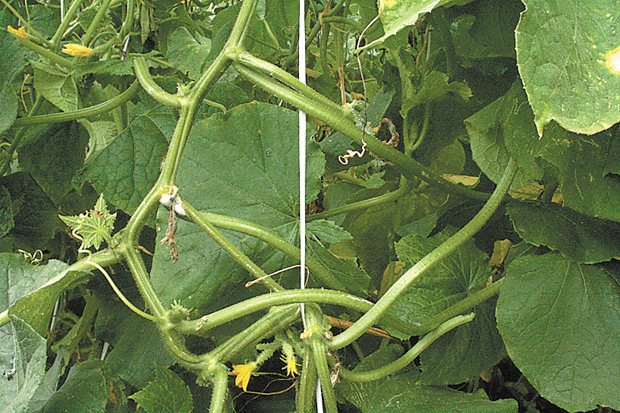

Patisson has fruits resembling a disc with rounded edges (or a flying saucer, it is not without reason that a variety called UFO appeared), and a dense crispy pulp. The skin of most varieties hardens when ripe, like the "Greek" zucchini.
The fruits of the kruknek look like zucchini, curved at the stalk - not without reason they got their apt name (translated from English it means "crooked neck"). In the company of vegetable varieties of hard-bore pumpkin, they have the most nutritious and nutritionally valuable pulp, but they are more thermophilic and demanding on growing conditions compared to squash and squash, and therefore are inferior to them in popularity.In addition, no domestic varieties have been registered yet.
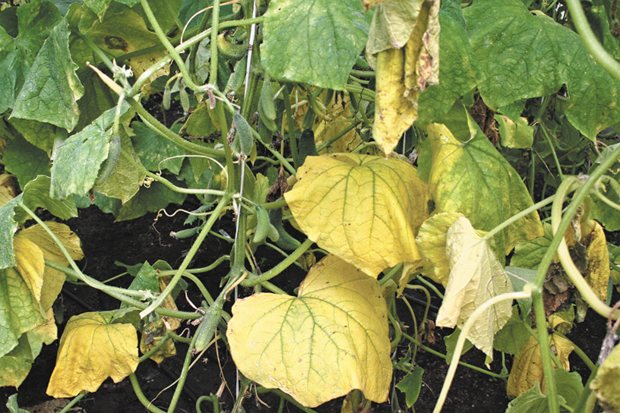

Types and varieties of cucumbers with photos and names
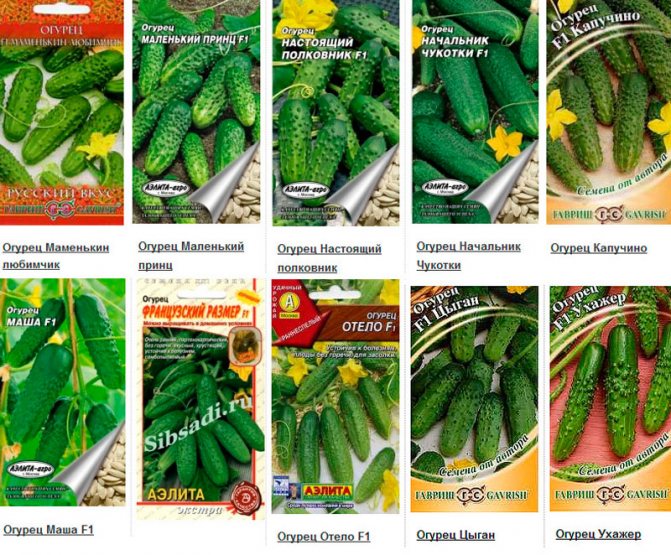

Cucumbers have many varieties, which are divided by purpose into canning, salad and universal. Canned varieties include those in which the fruits have a thin skin and a high sugar content, and this is of great importance when pickling and pickling. In greens of lettuce varieties, the skin is thicker and tougher, it does not allow the marinade and brine to penetrate into the fruit. But such fresh cucumbers are more delicious than canned fruits. Zelentsa of universal varieties are used both for making salads and for pickling.
Popular canned varieties: Business, Brigantina, Rodnichok, Favorite, Voronezh, Zasolochny, Urozhainy 86, Reliable, Nezhinsky local, Competitor, Cascade. The most popular salad varieties: Adam, Graceful, Movir, Saltan, Phoenix, Parade, Synthesis, Rzhavsky local. Universal varieties: Stork, Epilogue, Marinda, Regia, Duet, Cruise, Crane, Farmer, Sagittarius, Moravian gherkin, Khabar, etc.
Also, all varieties are divided according to the ripening time:
- early - ripen in 32–45 days;
- average ripening - ripening lasts 40–45 days;
- late - ripening duration from 50 days and longer.
Early ripe hybrids and varieties: Lilliput, Graceful, Bully, Emelya, Zadavaka, Blizzard. Average ripening varieties: Picas, Athlete, Stepnoy, Solnechny, Unity, Far East 27, Competitor, Topolek. Late-ripening varieties: Nezhinsky, Phoenix, Khrust, Secret, Chinese climbing, Spring, Chinese miracle, Parisian, Mother-in-law.
Also, this culture is divided into hybrids and varieties. Hybrid cucumbers, when propagated by seeds, are not able to preserve the varietal properties of the parent plant. At the same time, varietal cucumbers retain their varietal characteristics even after several generations. However, hybrid plants yield much earlier and more abundant crops, and they are also stored for a longer time and begin to turn yellow much later in comparison with varietal cucumbers. In this regard, varietal cucumber seeds are much cheaper in comparison with hybrids. Popular hybrids: Buyan, Marinda, Othello, Parker, Regina, Pasadena, Business, Ajax, Brigantine, Herman, Emelya, Katyusha, Swallow, Faithful friends, etc.
Still all varieties of such a culture are divided according to the type of pollination into self-pollinated and bee-pollinated. Bee-pollinated varieties are used for growing in open soil, they include: Athlete, Zhuravlenok, Zastolny, Graceful, Lyubimchik, Slavyansky, Katyusha, Competitor, Casanova, Nugget, Swallow, etc. Self-pollinated varieties, also called parthenocarpic, are grown in open ground, and also in the greenhouse, these include such varieties as: Adam, Aelita, Stella, Juventa, Russian style, Romance, Picnic, Navruz, Marta, Pasadena, Voyage, Danila, Amazonka, White Angel, etc.
According to the size of their fruits, they are divided into gherkins, reaching no more than 80 mm in length, as well as salad-type cucumbers, which are eaten fresh. The varieties bred by German breeders are related to gherkins, for example: Adam, Graceful, Othello, Libelle, etc.
The fruits are also divided by the nature of the surface into large-tuberous and small-tuberous. In this case, the thorns located on the surface of the zelents can be painted black or white. White thorn salad varieties include: Emerald Stream, Chinese Snakes and Chinese Heat Resistant. Salting black thorn varieties: Nightingale, Real Colonel, Salting, Lilliput, Aquarius, etc.
Also, for exotic lovers, rather unusual hybrids and varieties were created, for example:
Chinese long cucumbers


The length of their shoots is about 350 cm, and the zelentsov is 40–90 cm. Such fruits have high taste, and the varieties themselves are high-yielding, unpretentious and very easy to grow.The most popular varieties are: Chinese miracle, Chinese long-fruited, Chinese farm, Chinese white, Emerald stream, Lio Ming, Chinese disease-resistant.
Armenian cucumbers


They have an extremely unusual look. The length of ribbed zelents is about half a meter, and their weight can reach 1 kg. They are covered with a whitish-silvery downy. Scourges can be up to 400 cm long. These varieties are suitable for growing both outdoors and indoors. Popular varieties are: Silver melon, Bogatyr white, Mel he Flehu-ozus.
Italian cucumbers


This group of varieties received this name due to the fact that it was born thanks to Italian breeders. The appearance of such fruits is similar to the greens, belonging to the Armenian varieties, so they have a ribbed shape. The color of the peel directly depends on the variety and is pale green, for example, in the Tortorello (Watermelon) variety, its taste at the same time is similar to cucumber and watermelon. Also, greens can have a dark green color, which after a while is replaced by yellow-orange, for example, the Barrese variety, which has a watermelon flavor.
Crystal apple


In England, breeders were able to create an unusual hybrid, the fruits of which look very similar to lemons, but they taste like a simple cucumber. The scourge of such a plant can reach a length of 600 cm.
White cucumbers
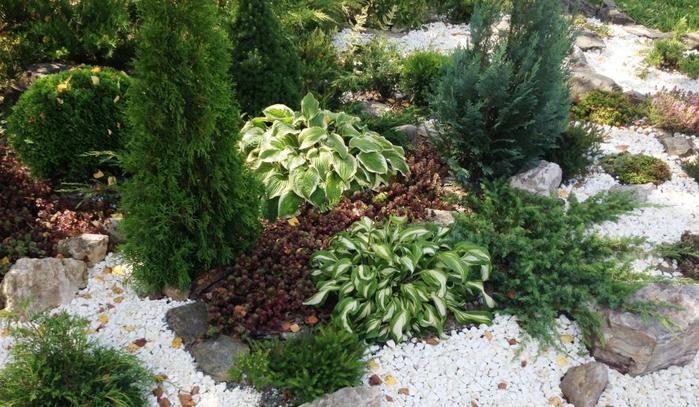

Such varieties with long shoots are suitable for growing both outdoors and indoors. They are highly resistant to disease and heat. Very delicate fruits have a sweetish taste and are about 20 centimeters long, but it should be borne in mind that they outgrow extremely quickly. Popular varieties: Italian White, Snow Leopard, Bride, Snow White, White Angel, Three White Leaves.
Melotria rough (mini cucumber)


This decorative liana is a perennial, it comes from Africa. The foliage has a bright green color that remains unchanged until October. Zelentsy reach only 25 mm in diameter, outwardly they are similar to small watermelons, which have a cucumber taste. They can be eaten fresh, or used for pickling or pickling.
Momordica (Indian cucumber)


This cucumber is suitable for growing at home and outdoors. The leaves of the bushes are very effective. The flowers have a rich yellow color and a jasmine scent. Elongated bumpy greens are painted in a dark green color, which eventually changes to a rich orange. Ripe green leaves open and become similar to a crocodile, which opened its mouth, therefore it is also called "crocodile cucumber".
Serpentine cucumber trichozant


Such a pumpkin plant is quite popular in Southwest Asia. It is distinguished by its resistance to disease and unpretentiousness. The length of the cylindrical fruits is 1.2 m, they wriggle like snakes. The color of the fruit is green, but over time it changes to orange. The flowers are similar to light snowflakes, reaching 40 mm in diameter.
Red cucumber tladiant dubious


This liana, which is native to Southeast Asia, is a perennial, its lashes are about five meters long. Heart-shaped leaf plates are greenish in color. The rich yellow flowers are similar in shape to tulips. Small fruits are suitable for pickling and pickling. However, fruits more than 15 centimeters long turn red and very sweet, and delicious jam is prepared from them.
Anguria varieties
Only one variety is registered in the state register - Anguria dietary... Recommended for growing in greenhouses and hotbeds. Early maturing, ripens in 47-52 days. The plant has high rates of shoot formation, weaves well. Stems are thin, fragile. Fruits are light green in color, with white stripes and soft thorns, oval in shape, up to 6 cm long. The pulp is yellow-green, medium-dense, juicy, has a high taste.
Lovers of this plant mainly cultivate foreign varieties.
Also, they are often grown:
- Anguria variety "Gourmet". Grown as a vegetable and ornamental crop. Lianas grow about 3 m long. Fruits are oval, light green, with large, juicy thorns. Young fruits are eaten, overripe, when they change color, can be dried and used in floristic compositions.
- Syrian Anguria variety... The variety is distinguished by early ripening periods, lianas up to 4 m in size, and a large number of shoots. Fruits up to 7-8 cm in size, weighing up to 50 g, are covered with small thorns. Young fruits have high decorative properties, look beautiful on the plant and as a decoration for dishes, sweet in taste, light green in color. Fruiting from July until frost. Grown on trellises.
Kiwano (Cucumis metulifer or horned melon, or African cucumber) is considered to be a plant closely related to Anguria. Its fruits are dark green in color and have large, fleshy thorns. Weight up to 300 g. Cucumber taste with hints of either banana or something else.
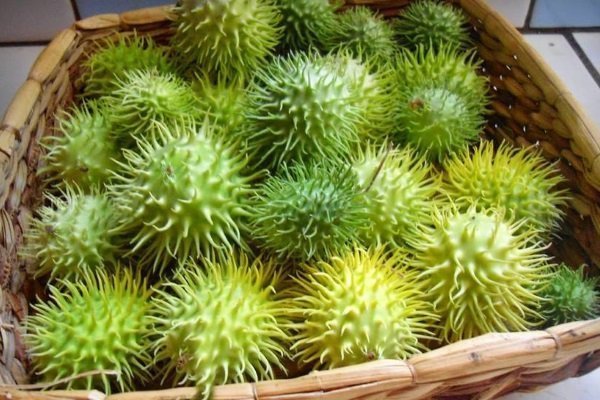

Anguria "Gourmet"
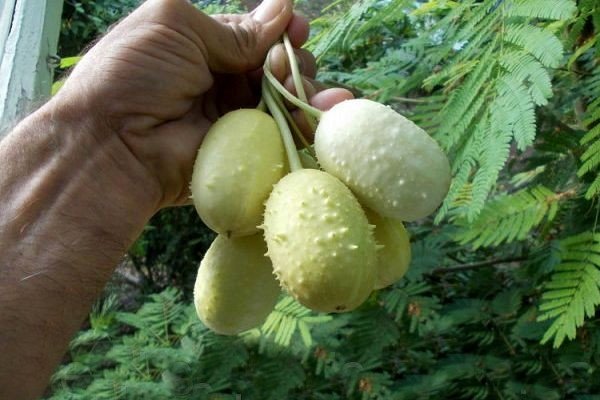

Syrian Anguria
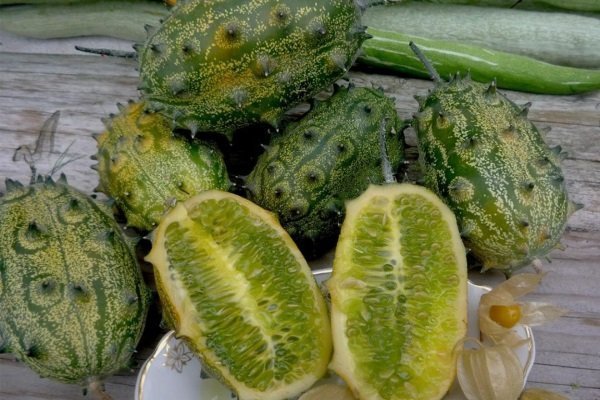

Kiwano
First steps after purchase
Storage at a temperature of + 15 ° C and a relative humidity of 50-60% allows the seeds not to lose their germination for up to 10 years.
The sowing time is calculated in such a way that by the time the seedlings are planted in the open ground, the temperatures at night do not fall below + 10 ° C.
Seed treatment before sowing is designed to accelerate germination, harden plants, increase disease resistance and increase yields.
Seed-growing enterprises themselves disinfect the seed by the thermal method, keeping it for 2-3 hours at + 60 ° С. Homemade seeds should be soaked for 15 minutes in a 0.5% solution of potassium permanganate. Also for etching can be used:
• "Alirin-B";
• "Baksis";
• "Baktofit";
• "Pseudobacterin-2";
• Planriz;
• "Fitosporin-M".
Among the growth regulators that improve germination and increase yields, we can recommend:
• "Ambiol";
• "Immunocytophyte";
• "Epin-extra";
• "Germination";
• "Zircon".
These drugs should be used in accordance with the manufacturer's recommendations.
For old seeds with a shelf life of 6 years or more, bubbling is useful - keeping for a day in water with a connected aquarium compressor that saturates the water with oxygen.
Wet seeds can be hardened in the refrigerator at temperatures between zero and two degrees. The exposure time is two days. The seedlings will be more resistant to nighttime cold weather, which usually causes stress in inherently tropical plants.
Seeds prepared for sowing are poured with water. Those that surfaced are discarded. The rest are placed in a humid environment until pecking. Peat or plastic pots are well suited as containers. They are filled with a light nutrient substrate. For example, the following composition is suitable: 4 parts of compost, 3 parts of peat, 2 parts of turf, 1 part of sand. One or two seeds are placed in each pot. The optimum room temperature is + 25 ° С. After sprouting, the temperature must be lowered, otherwise the sprouts will stretch out strongly.
The first two true leaves indicate the need for feeding - 10 g of saltpeter, 20 g of potassium sulfate and 30 g of superphosphate are diluted in a bucket of water. Before planting, seedlings are fed a second time: 10 liters. dilute 20 g of potassium sulfate and 50 g of superphosphate.
In southern areas, cucumber seeds can be sown outdoors. In this case, the soil should be warmed up to + 15 ° C. Dig small holes, place four or five seeds in each and sprinkle it with earth by 2 cm. After germination, excess plants are cut at the root so that the plantings are not thickened. It is not worth pulling out so that the root system of the selected seedlings is not damaged.
Before planting in the ground in a permanent place, it is recommended to harden the seedlings. For this purpose, the pots are brought out into the air in partial shade.At night and in extreme heat, young plants are brought back into the room to protect them from stress. A good seedling should be 25-30 cm tall, with short internodes, well-developed roots and rich green leaves.
Reproduction of the Antilles cucumber
As an annual plant, the Antilles cucumber does not make sense to grow by cuttings or shoots, it is grown only from seeds. In the conditions of the climate of Russia, it is preferable to grow Anguria using the method of potted seedlings.
Sometimes, if seed germination is low, some gardeners advise:
- pinch off a shoot up to 15 cm in size;
- remove 2 sheets from the bottom;
- put it in a growth stimulator for 24 hours;
- plant on the garden bed, covering the top with a jar.
After 2 weeks, the live bait should take root and grow.
Why does the variety have different names?
The name "Anguria", according to some sources, in Sanskrit means a homonym of one of the rulers of India, who had several tens of thousands of children, hinting at a large number of seeds in the plant. The Slavs pronounced this word as "cucumber", from which the name "cucumber" came.
Today you can find the following plant names:
- Antilles cucumber - comes from the name of the plant's homeland;
- Horned cucumber or hedgehog cucumber - due to the appearance;
- Mashish (maxixe) - this is the name of this plant in Brazil.
You can often hear that Anguria is called a watermelon cucumber, hinting at the similarity of the leaves of these plants. But in fact, this is the correct name for another type of plant - rough melotria (Melotria shcabra or Cucamelon, or Mexican cucumber / Mexican watermelon). The fruits of melotria look like a small cucumber with a watermelon color (unlike anguria, the fruits of melotria have no thorns). They also taste like cucumber.
Description of bush cucumbers
The length of the stems is the main difference between bush cucumbers and ordinary ones. If the stem in the form of a whip grows three meters or more, the standard size of a cucumber bush is 30 cm. Some varieties can grow up to 70 cm, but this is the limit.
- Bush cucumbers look very decorative.
- Numerous ovaries are located on a neat lush bush.
- The leaf mass is larger, since the internodes are shorter.
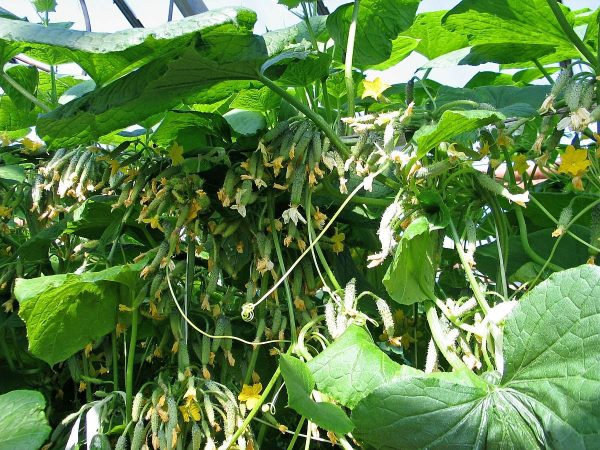

Bush cucumbers
- Lateral lashes are missing (sometimes one or two processes can form, but this is rare).
- Almost all varieties of bush cucumbers are early ripening.
- The harvest is given amicably, so it can be harvested within a few weeks, without stretching the fruiting for months.
- The fruits are small and almost all short (up to ten centimeters) - ideal for canning.
And the most important advantage of bush varieties over climbing ones is the saving of the garden area.
By the way. Each meter of the plot is of great value for those who are engaged in gardening. Especially if the plot is small, you have to choose between priority crops. Bush cucumbers help you get a good harvest and leave room for other vegetables.
What to do if the transience of fruit ripening and return is not considered an advantage? If you want to get cucumbers throughout the season? Sow early, medium and late varieties. Each of them will yield the harvest for three weeks. And after harvesting the fruits, it is quite possible to plant other vegetables or herbs in place of the early and middle varieties, and they will have time to ripen before the end of the season.
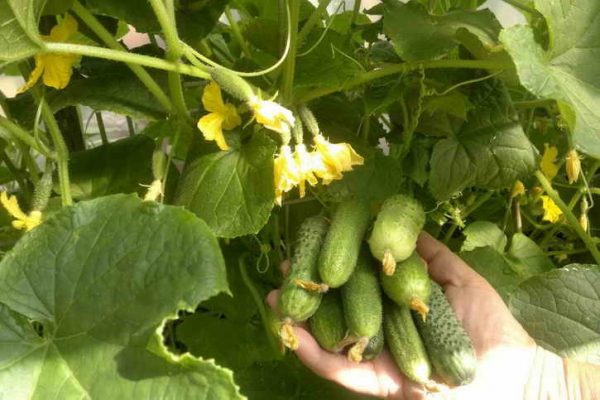

Early harvest
Planting Anguria seedlings
The best time for sowing seeds for seedlings is the beginning of April.
Procedure:
- Seed selection. Go through the seeds, select only large ones.
- Disinfection. Disinfect the planting material in a solution of potassium permanganate.
- Using a root former. A day before germination, soak the seeds in a solution of a root former, for example, Epine.
- Germination. Spread the seeds on several layers of cheesecloth and cover with the same cheesecloth on top.Put in a warm place and make sure that the fabric does not dry out. When the seeds hatch, you can replant them.
- Transfer. Use peat tablets, this will preserve the root system when transplanting into the ground. Rules: pour a peat tablet with water for 5 minutes;
- after it increases in height, drain off excess water;
- increase the depression in the middle to 1 cm;
- put a seed in it and close up.
You can use peat or paper cups 8-10 cm deep filled with seedling soil.
- The first shoots. Wait in a week.
- Bedding. When 2-4 true leaves appear on the stems, the seedlings can be transferred to the garden bed.
To prevent the Anguria stems from stretching too long due to the lack of light, additionally install fluorescent lamps above the seedlings.
Popular recipes
In cooking, cucumbers are used in fresh, pickled and pickled forms. Vegetables are used to prepare salads, cold soups, sauces and dressings.
Recipe number 1 "Pickle with pickles"
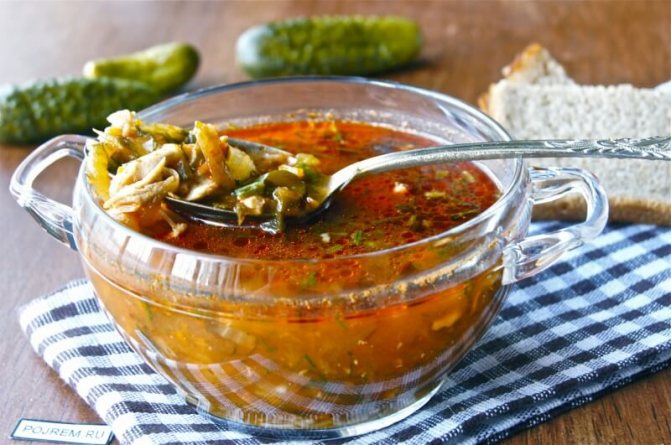

Ingredients:
- beef fillet - 350 g;
- pickles - 300 g;
- potatoes - 200 g;
- pearl barley - 150 g;
- sour cream - 150 g;
- carrots - 80 g;
- onions (blue or white) - 50 g;
- tomato paste (ketchup) - 30 ml;
- dill (dry) - 20 g;
- vegetable oil - 20 ml;
- spices, fresh herbs - to taste.
Cooking scheme:
- Cut the meat fillet into pieces, boil for 1.5 hours.
- Pour the pearl barley with liquid, boil in a separate container for 25 minutes. After cooking, leave the porridge for 15 minutes for further swelling.
- Throw the prepared cereals on a sieve, rinse under running water, combine with meat broth.
- Peel the cucumbers and large seeds, and then cut them into strips.
- Chop vegetables: onions - in half rings, carrots - in slices, potatoes - in cubes.
- Heat a frying pan with vegetable oil. Saute onions and carrots, and then combine with tomato paste, leek and 50 ml of boiling water. Put out the resulting mixture for 7 minutes.
- Strain the broth, combine the liquid with the potatoes. After 15 minutes, add porridge and cucumber slices to the pickle. Boil the dish for another 5 minutes.
- Fry the boiled beef until golden brown.
- Add grilled vegetables, meat, spices, fresh herbs to the pickle, boil for another 3 minutes.
- Insist the first dish under a closed lid for 15 minutes.
Serve the pickle with fresh sour cream and a sprig of herbs.
Recipe number 2 "Korean Cucumbers"
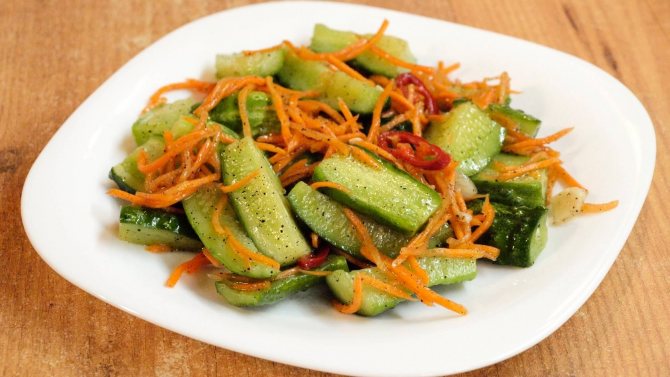

Ingredients:
- cucumbers - 500 g;
- carrots - 150 g;
- onions (white) - 100 g;
- lean oil - 80 ml;
- garlic - 70 g;
- vinegar (preferably apple cider) - 50 ml;
- sesame seeds - 45 g;
- seasoning for Korean salads - 20 g;
- fresh herbs, salt to taste.
Cooking principle:
- Chop vegetables: onions - in half rings, cucumbers - in strips, carrots - in bars. Stir the mixture thoroughly, and then make a small depression in the center (for garlic).
- Heat a frying pan with oil until a slight "haze". Add sesame seeds and spices to the heated fat. Korean salad dressing can be substituted with a mixture of equal parts coriander, paprika, ginger, black pepper, and red pepper.
- Place the minced garlic in the well made in the vegetable mixture and pour the hot spiced oil on top.
- Season the salad with salt, sugar, vinegar and herbs.
- Stir the garnish, carefully distributing the seasonings, garlic and sesame seeds over the vegetables.
- Mash the cucumbers and carrots with your hands until the juice stands out slightly.
- Place the salad in the refrigerator for 6 hours (for pickling).
Korean cucumbers can be used as a separate appetizer or as a side dish for main courses.
Sowing method of growing cucumbers
We recommend reading our other articles
- The best self-fertile varieties of plums
- Root celery
- Broiler guinea fowl
- Clematis Multi Blue
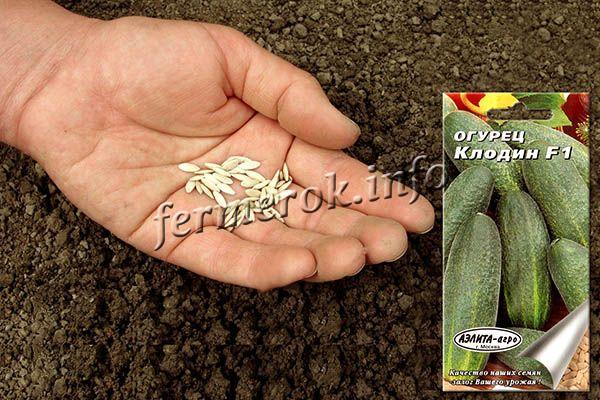

Direct sowing is carried out in the ground around the end of May or at the beginning of June
Direct sowing is carried out in the ground around the end of May or early June. It is important that by the time of landing, the ground warms up to +8 degrees, and the air to +10. The land for sowing must be prepared in about 1-2 weeks. Per square meter of the site take 20 g of ammonium nitrate, 30 g of superphosphate, 15 g of potassium sulfate. After that, the earth is dug up and loosened.
Seeds are placed in the holes at a distance of 30 cm from each other. About 50 cm of free space is left between the rows. The sowing depth of seeds is 2-3 cm. If the nights are still cold, it is worth covering the planting with white agrofibre to protect it from freezing.
Important!
Seeds should only be sown in moist soil. Then they will germinate faster.
Harvesting and processing
The crop will be ready for harvesting in about 40 days after the first shoots of cucumbers have appeared. It is worth collecting greens immediately after ripening in order to prolong fruiting. But in principle, the fruits can hang on the bushes for a long time, they do not barrel, retain their taste even when overripe.
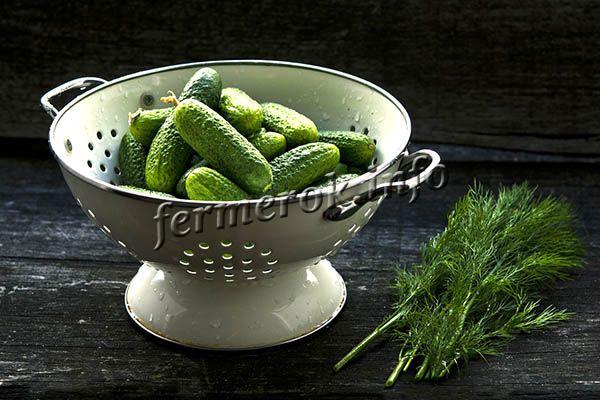

Cucumbers are suitable for preparing fresh salads, summer snacks, and it is better not to take them for salting
The crop is recommended for fresh consumption. Cucumbers are suitable for preparing fresh salads, summer snacks. But it is better not to take them for salting. Due to the thin skin, they are very softened, and the taste can deteriorate.
Interesting!
You can store the harvested crop in a cool room or in the refrigerator for 2-3 weeks.
Exotic
Acquaintance with momordika, melotria, anguria, lagenaria and chayote is more informative than practical for the inhabitants of the middle lane. But in the Krasnodar Territory, they feel great and find themselves admirers. In Sochi, I was shown lagenaria, a pumpkin "with a waist" - a gourd from which you can make a jug. Chayote was planted in a film greenhouse at the Adler station of the Research Institute of Vegetable Growing. One plant was enough to form a huge light green umbrella by the middle of summer, under which several people could hide from the unbearable heat (the whips of the "Mexican cucumber" are such that, if not pinched in time, they will grow up to 8 meters). Numerous chayote fruits are white-greenish in color and resemble quince in shape. The pulp is dense: in order to prepare the salad, it had to be planed on a grater.
Cultivated plants Fruit. Fruit crops are fun
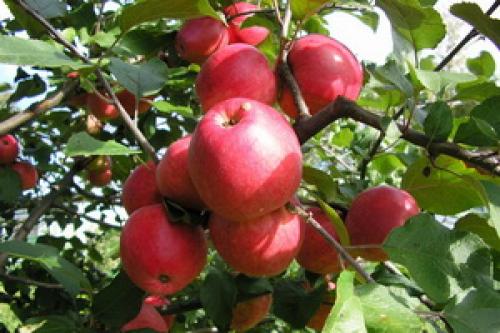

Modern fruit crops are an interesting and exciting activity for any gardener. Thanks to selection, a huge number of varieties and types of fruit trees have been bred, which give a guaranteed yield even in the most unfavorable growing conditions.
We offer you an overview material, after studying which, you will understand that fruit crops are not only interesting, but also useful in terms of obtaining additional yields of fresh fruits and berries for the diet of your family.
Growing fruit and berry crops
Growing fruit and berry crops in the garden is a beautiful and interesting activity. It's also beneficial - the fruits are harvested directly from the tree or bush, so they are really fresh and you can grow varieties and species that are not sold in stores. First of all, this is your apple or strawberry, which you have grown with your own hands.
Despite the beauty of growing your own fruit, horticulture was not popular until the self-farming movement burst onto the scene. Only one garden out of three grew any fruit at all, and there were two main reasons for the lack of interest in this.
First, fruits were thought to be labor intensive and time consuming. Indeed, there are some types that require regular maintenance, but an orchard, once planted and begins to bear fruit, gives more return and with less effort than a vegetable garden.Some textbooks may have been partially responsible for this negative view. There are descriptions of pruning, according to which it is as difficult as brain surgery. And in them it was fashionable to recommend a fungicide or insecticide for almost all uninvited guests.
Secondly, many people believed that fruit growing requires a lot of space, and imagined stairs to collect fruits from the tree.
Times have changed. The DIY movement fueled the desire for homemade produce, and the post-World War II progress made fruit growing available to any garden.
Fruit crops include various trees
Garden centers offer containerized trees and shrubs that can be planted any time of the year, while dwarf rootstocks produce apples and pears that are not much larger than rose bushes. Fruit crops include shrubs and various trees. So, fruit growing is fine for you, but a word of caution must be said. Planting a fruit tree or shrub is a long-term investment, so read this chapter and perhaps a book on fruit growing before going to a garden center or ordering from a catalog. Choose carefully, making sure that both the type and variety are suitable for your conditions. Think about your gardening time too. If limited, then “light” crops such as dwarf apples, autumn-bearing raspberries and container-grown strawberries are chosen.
Fruit trees are types and types of horticultural crops
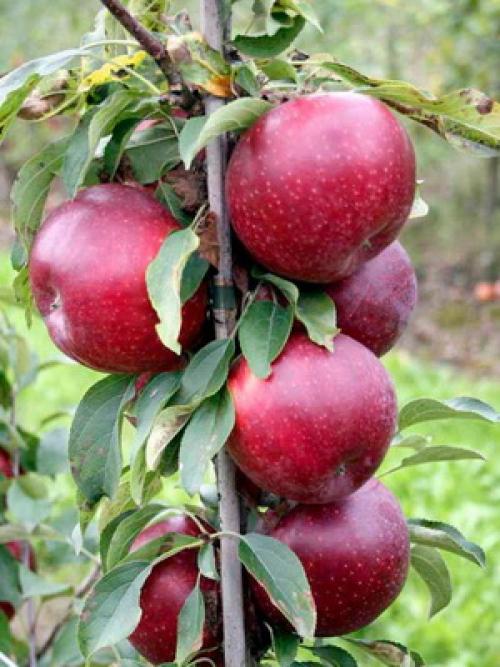

Fruit trees are common types of garden crops for growing in a backyard. There is no precise definition of a fruit tree - this includes large and sturdy plants with edible fruits. Almost all are tree-shaped (with one main trunk) in their natural state, but some (like quince) are shrubs.
Most of the species of fruit trees belong to the Rosaceae family, and their choice is wide enough. In this chapter you will find detailed information on the four most popular of them, for others see the book on fruit crops. Remember that fruit trees will be with you for many years, so choose your site carefully and prepare the soil properly.
The possible height of a tree will depend on its type, growing conditions, and the rootstock on which the variety is grafted. The growth pattern is determined by pruning and shaping.
Choose the sunniest spot available - full sunlight and a mild climate are important for vulnerable types. The soil should be sufficiently deeply cultivated and not prone to waterlogging.
There are a number of questions to consider before choosing a strain. Choose dessert (for food) varieties over culinary (for processing) varieties if space is limited - you may find one or more dual-use varieties in catalogs. A commercially available variety may be self-sterile and require a suitable partner nearby to pollinate. Additional information on this subject can be found for each individual variety. Consider buying a family tree (a plant with several compatible varieties grafted onto it) if you are only going to plant one tree.
The main factor that determines the final size of the tree is the rootstock that was used.
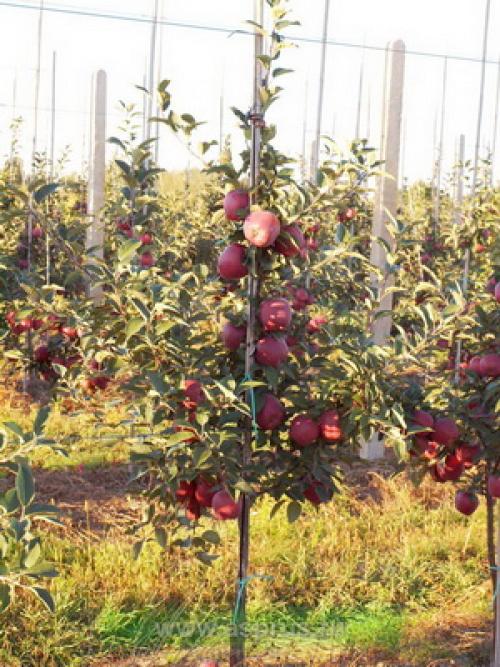

The M27 apple tree is the dwarfest stock.
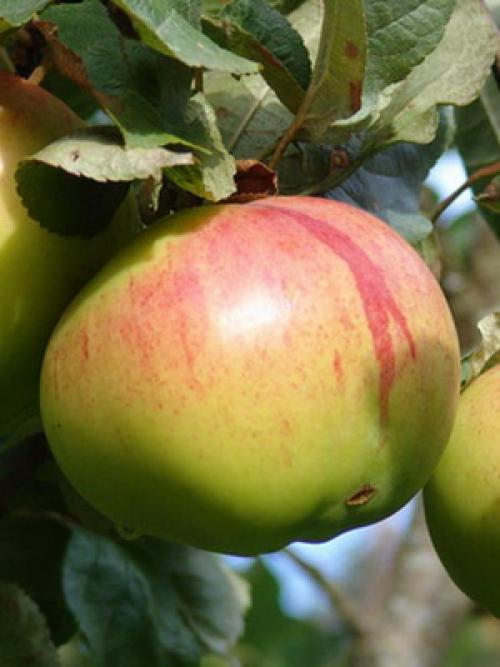

M9 and M26 are dwarf rootstocks used for small shrubs;
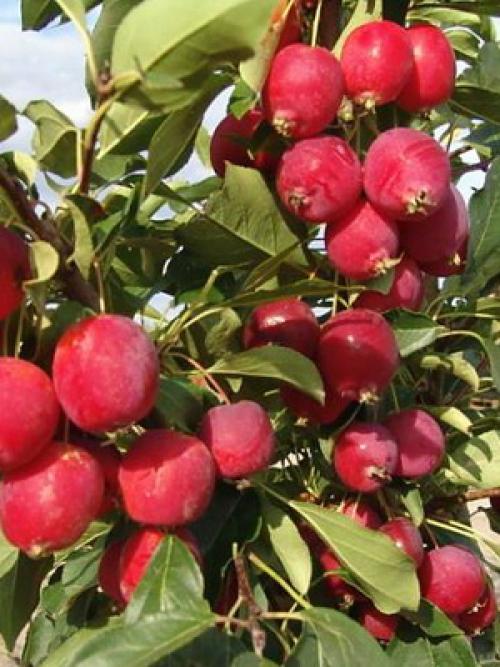

MM106 is used for large bushes,
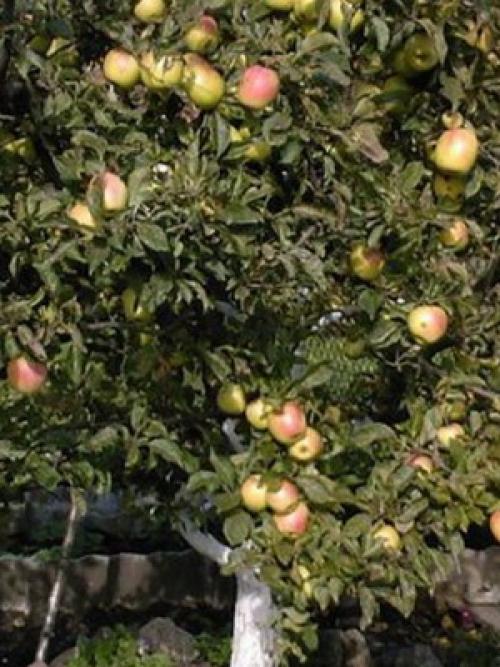

MM111 - rootstock for semi-stem trees.
Fruit stone fruit crops
| 1-year | Unformed. You will need to prune for about 3 years to produce a satisfactory branch structure. |
| 2 years | Partially formed.You will need to continue shaping to produce a satisfactory texture. |
| 3-4 years | Formed. The purpose of pruning will be to maintain a balance between growth and fruiting. |
| More than 4 years | Usually too old to plant. It can take root very slowly. |
Selection and preparation of soil and planting sites
In different climatic conditions, the arrangement of cucumber beds is somewhat different. And if in the southern regions planting is usually carried out on a flat surface, then in the middle lane more or less high ridges are equipped. To create a better air-thermal regime on heavy soils, the ridges are poured higher, on light warm soils they are made low. On the slopes, the ridge is made across the slope, on a flat surface - taking into account the best solar heating - from east to west.
In areas with a high groundwater level and with heavy cold soils, it is widely practiced to sow cucumbers in separate elevated bulk holes located at a distance of up to a meter from one another. In dacha practice, the cultivation of cucumbers on wall ridges with or without film cover is often found. To do this, use the southern walls of buildings or blank fences. If this is not possible, cucumbers are grown on trellises, protected from the leeward side by a shield made of boards or foil.
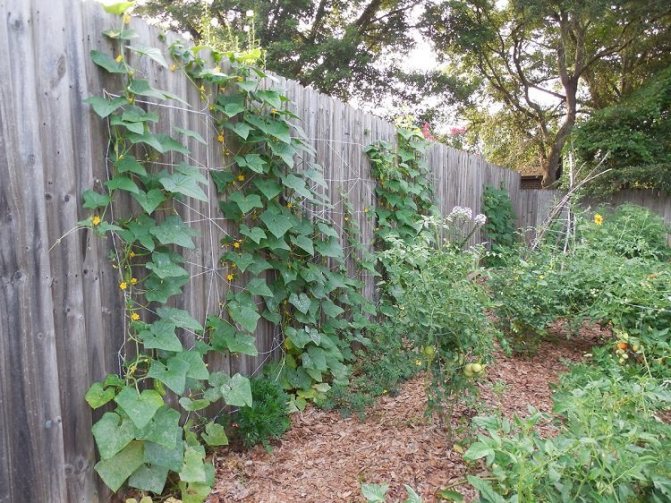

The fence is an excellent natural support for cucumbers, at the same time protecting them from the winds
In addition to being thermophilic, cucumbers require higher doses of fertilizers, especially organic ones, compared to many crops. Without a good filling of the beds with nutrients, the yields are late and are small. Even fresh manure is well suited for cucumbers, especially if you close it up for autumn digging. But it is better, of course, that the manure is at least half-rotten, cucumbers can use such fertilizer at the very first time. Peat-compost mixtures are also suitable, but mineral fertilizers are still added to any organic matter - 100 g / m2 of nitrophosphate or at least a half-liter can of wood ash.
Cucumbers feel good in high warm beds. For their arrangement, at the end of last summer, they dig a hole up to 30 cm deep according to the size of the future garden bed. Various waste is dumped into it: plant tops, small branches, fallen leaves, household waste, various cleaning. All this is periodically watered with infusion of mullein or chicken droppings, sprinkled with earth or peat. In the fall, they throw in good soil and form a ridge, limiting it along the sides with boards or slate.
In the spring, the bed is sprinkled with ash, loosened, watered with warm water and covered with a film until sowing cucumbers. In the northern part of our country, the film is not removed at all, but holes are made in it, where seeds are sown or cucumber seedlings are planted.
Planting cucumber seeds in open ground
You can plant cucumbers with seedlings and seeds. The second method is more suitable for southern areas, where spring comes earlier, and the soil begins to warm up in April. And yet, planting cucumber seeds in the garden is carried out no earlier than May, after planting seedlings, when the spring weather finally came into its own.
The choice of method is the personal preference of each farmer. But they must take into account the type of planting material for use: whether they will be hybrid varieties or collected from the harvest with their own hands and adapted to the conditions of the region. And the thing is that hybrids are undoubtedly more fertile, but they are much more demanding on growing conditions, and it is more convenient to provide these conditions in a greenhouse.

